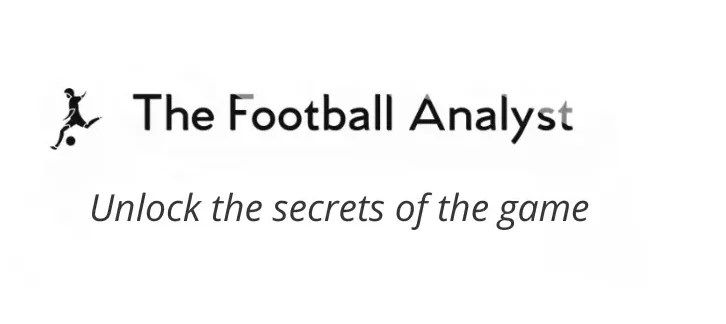Kjetil Knutsen has transformed Bodø/Glimt into one of the most exciting and tactically intriguing teams in European football. Known for their relentless attacking style, quick transitions, and intense pressing game, Bodø/Glimt has captured the attention of fans and analysts alike. This tactical analysis explores Knutsen’s approach, dissecting the principles that define his team’s success. By delving into formations, key player roles, and the strategies behind their high-paced game, we’ll uncover what makes Knutsen’s Bodø/Glimt a formidable force on the pitch.
Build-up
In the build-up, Knutsen sets his team up in a 1-4-3-3 formation, with a back four, one number-six, two number-eights, and a front three.
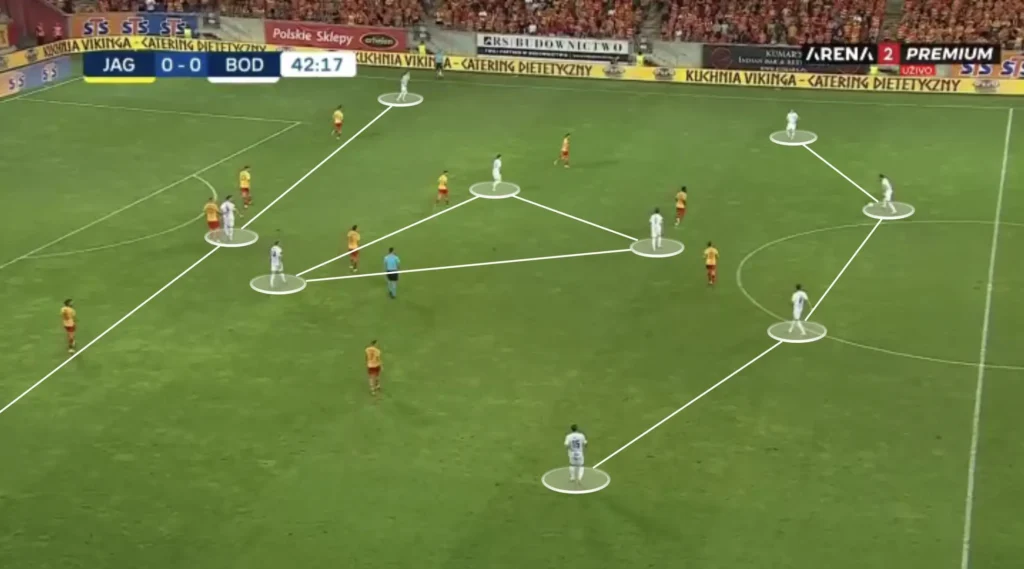
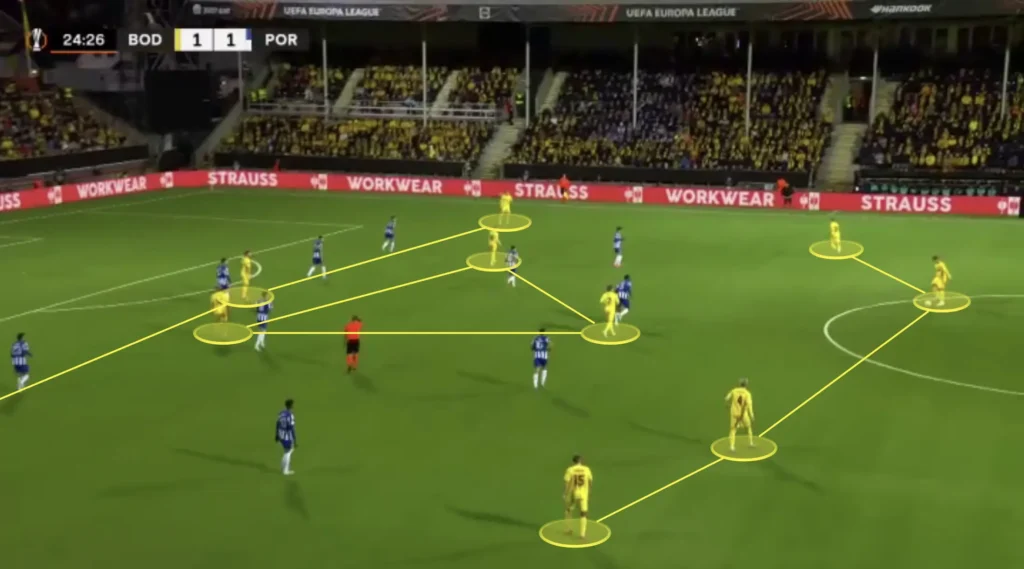
Building up in a 1-4-3-3 formation focuses on creating a solid foundation at the back while maintaining fluidity and options in the midfield. The formation begins with four defenders, who provide width and stability, allowing for controlled possession from deep areas. The single defensive midfielder connects the defense to the midfield, dictating the tempo and distributing the ball to the two more advanced central midfielders. These midfielders position themselves to exploit spaces between the opposition’s lines, creating passing triangles that facilitate smooth progression up the pitch. The three forwards, with the central striker as the focal point, are always ready to receive the ball, either through direct passes or by making runs behind the defense. This setup allows the team to transition quickly from attack to defense, maintaining pressure on the opponent while ensuring defensive coverage.
Rotations and Fluidity
The Bodø/Glimt players constantly rotate during the build-up. The team adopts a dynamic approach, shifting between formations to create numerical advantages and exploit spaces. Knutsen’s focus is always to get the players into their best positions, where they can make the most out of their individual skills. He emphasizes versatility, with players interchanging positions seamlessly to maintain possession and disrupt the opposition’s defensive structure. This flexibility creates numerical superiorities in different areas, allowing Bodø/Glimt to bypass the opposition’s press while maintaining control.
Their most common rotation is to come in with one of the fullbacks and push the other one up into the midfield. This shift creates a back three, allowing them to maintain defensive stability while gaining more control in possession.
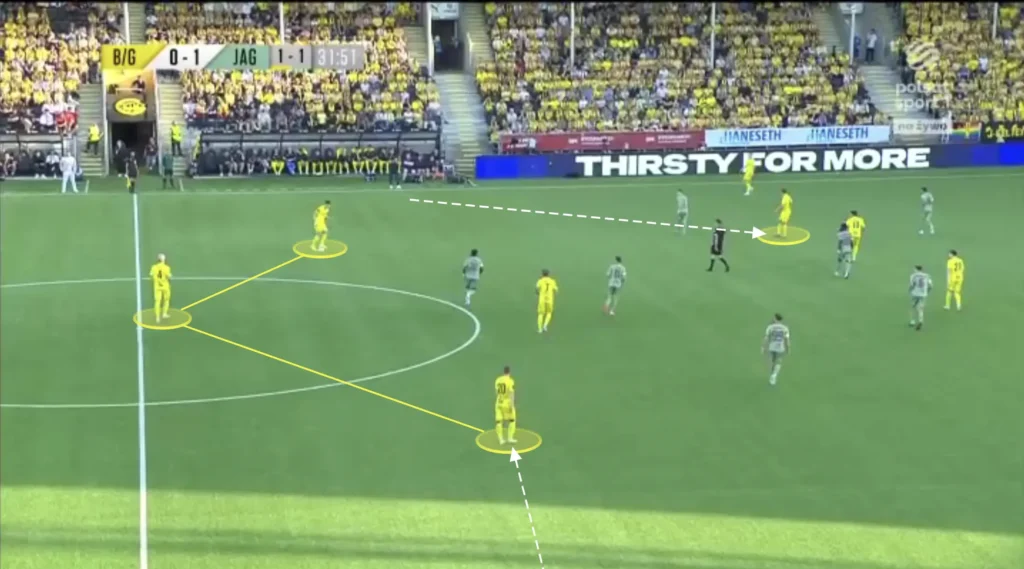
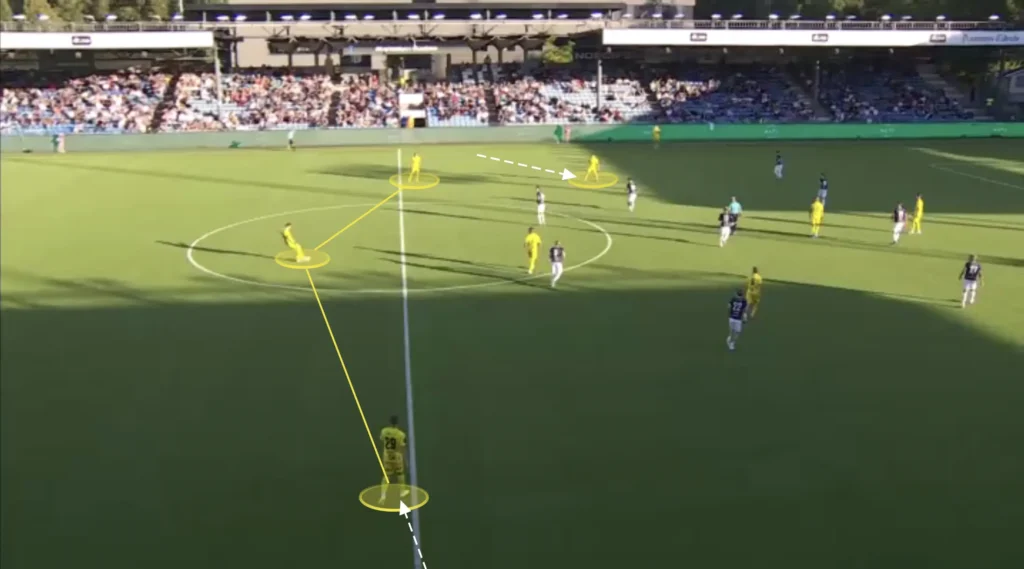
By doing this, Bodø/Glimt not only widen the field but also open up different angles for passing, making it easier to beat the opposition’s press. This tactical adjustment also gives them more options in progressing the ball up the field and disrupts the opponent’s pressing structure, helping them maintain fluidity in their play.
While it demands a lot of technical and tactical skills from the players, this fluidity has created new dynamics for Bodø/Glimt’s attacking style, offering new solutions and ways of beating the opposition’s press. It enhances their ability to control the game while opening up opportunities for incisive passes and creative plays.
High Backline
A massive aspect of Bodø/Glimt’s high possession build-up is to have the defenders high up. This helps in the counterpress because they get closer to the midfield. Having more players close to the center who can win the ball back makes it difficult for the opposition to do anything when they win possession. Furthermore, the high backline shortens the distance between players, shortening the time and length of the passes and preventing the opposition from pushing up their defense.
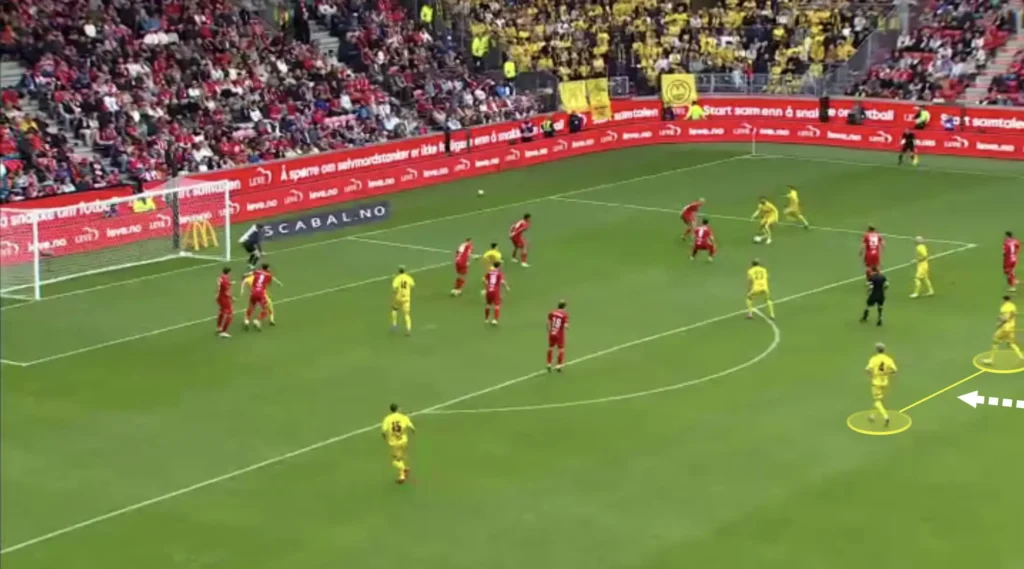
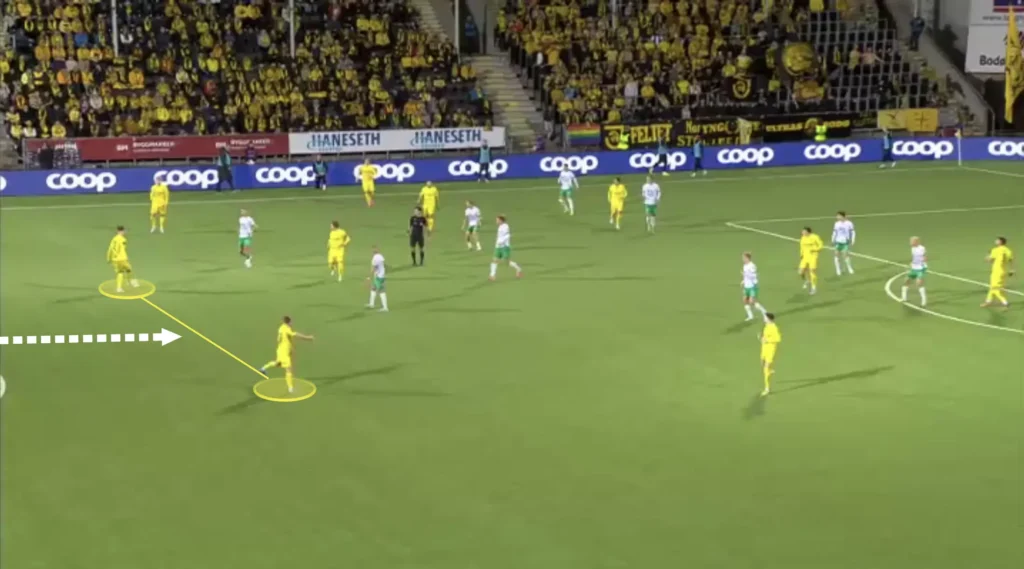
Finding the Number-Six
Bodø/Glimt consistently emphasizes playing through their number-six, Patrick Berg, during the build-up phase, making this role central to their progression up the field. By directing the ball to the number-six, Bodø/Glimt can quickly establish control in midfield, using this player as a pivot to link the defense with the more advanced attacking players.
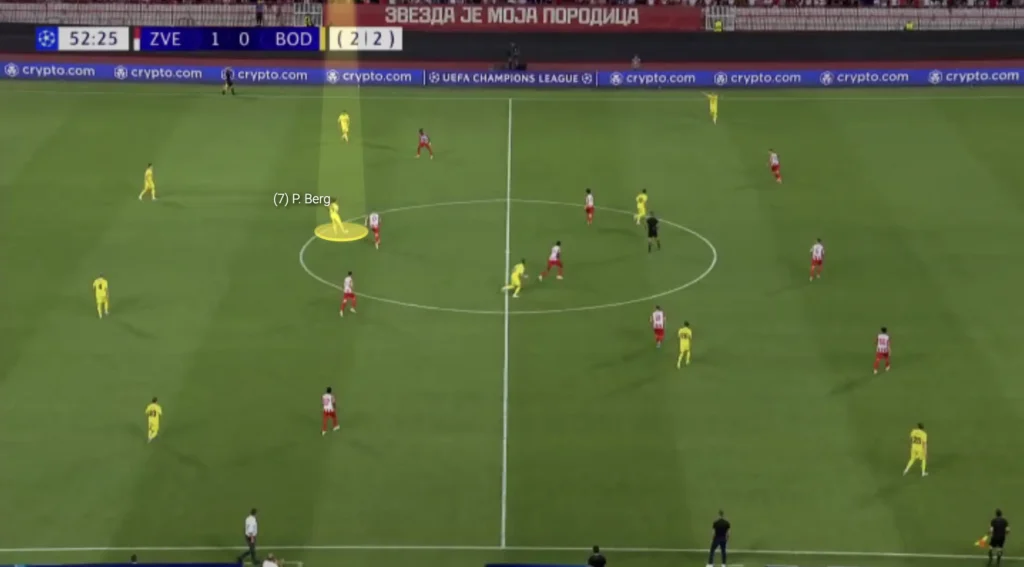
Patrick Berg is highly mobile and strategically makes runs outside the opposition strikers to make it easier for the center-backs to find him directly. This positioning allows him to act as an accessible passing option, bypassing the opposition’s first line of press and ensuring smoother transitions from defense to midfield. By staying in this pocket of space, Berg can receive the ball under minimal pressure, enabling him to quickly assess his options and either turn with the ball or distribute it to advancing players.
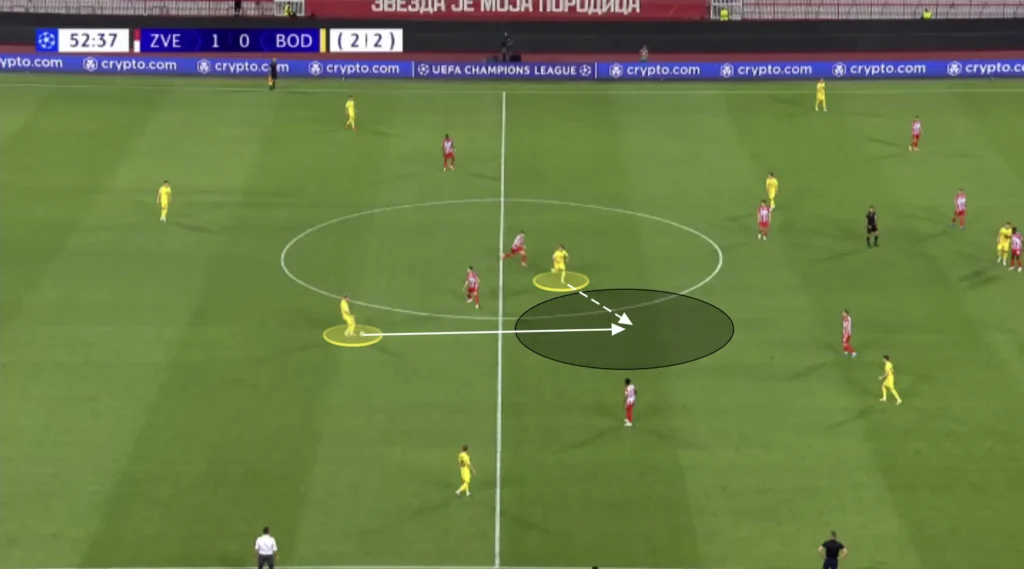
Bodø/Glimt will also use third-man combinations involving the number-eights to find the number-six in the space behind the opposition strikers.
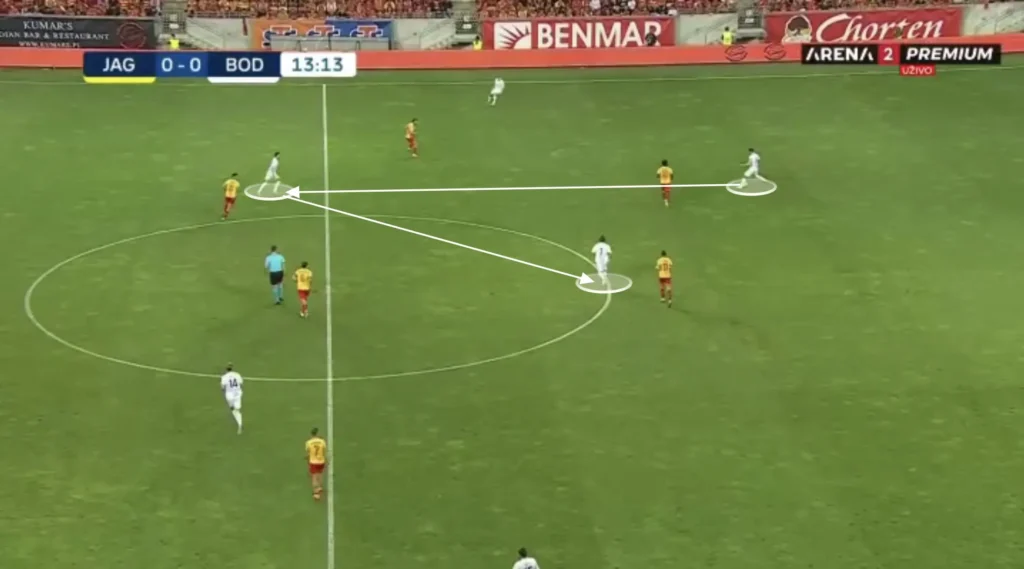
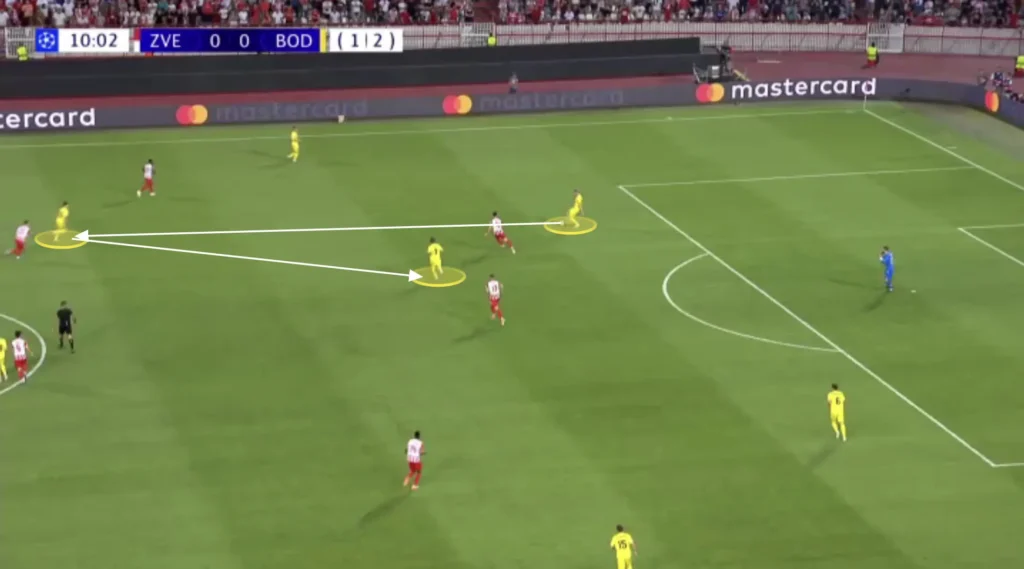
Inverting the Far-Side Fullback
Bodø/Glimt’s use of the far-side fullback is a distinctive feature in their tactical setup, especially when the ball is on the opposite flank. In these situations, the far-side fullback tucks into the midfield, adding numerical support and enhancing the team’s shape. This movement helps Bodø/Glimt maintain balance, preventing large gaps from opening up on the far side, while also preparing for any potential counterattacks. By drifting inward, the far-side fullback offers an additional passing option for circulating the ball and can act as a safety valve in case of a quick transition by the opposing team. This positioning also allows Bodø/Glimt to maintain a compact structure, ready to press immediately if possession is lost, and keeps them poised to recycle the ball back into play smoothly, supporting their fast-paced, attacking style.
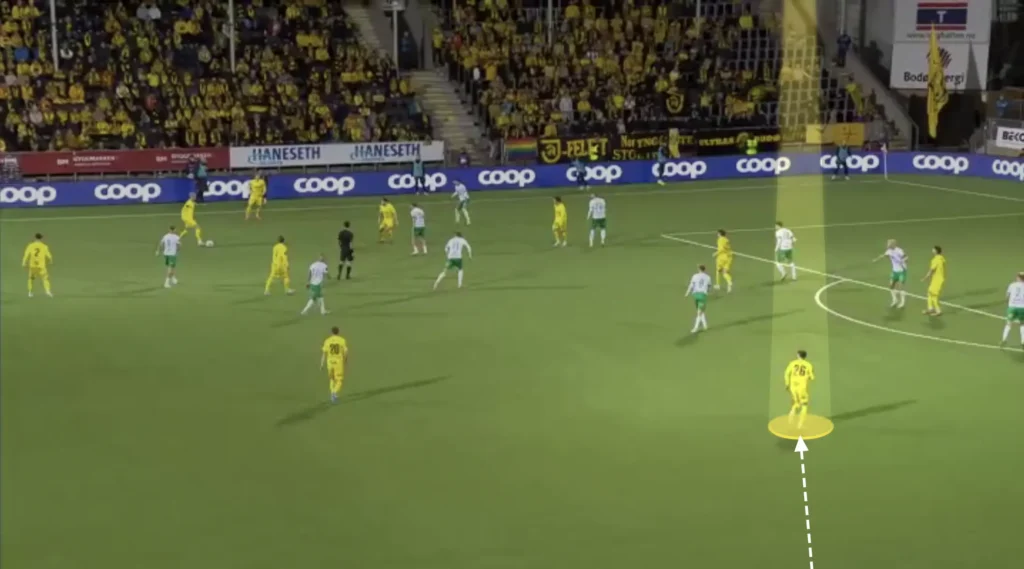
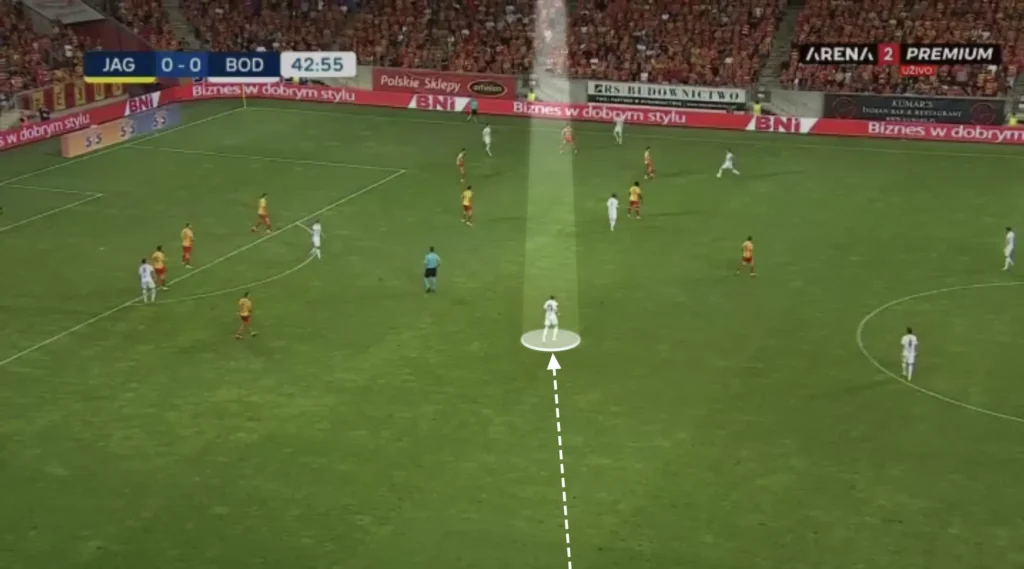
Additionally, Bodø/Glimt frequently utilizes their fullbacks to switch the play, exploiting the open spaces on the weak-side(the other side from where the ball is). When they seek to progress the ball, they often shift it across the pitch to the fullback on the far side. This switch of play helps them bypass congested central areas, allowing the fullback to receive the ball in more space. From this position, the fullback can then advance the ball into the final third, link up with midfielders, or look for forward runs from wingers and strikers. By progressing the ball through the fullback, Bodø/Glimt can maintain their attacking momentum, pulling defenders out of position and creating gaps for quick combination play.
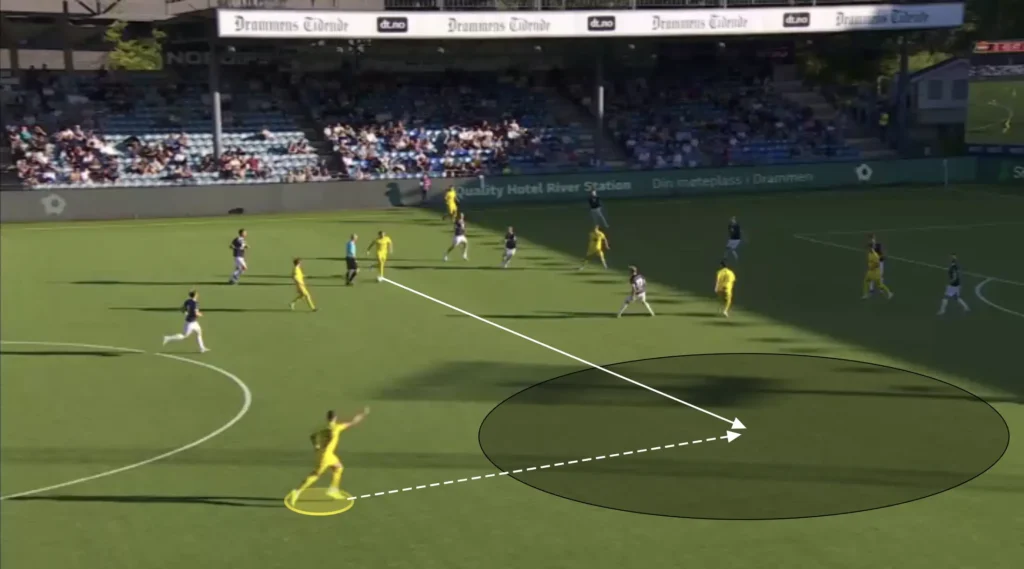
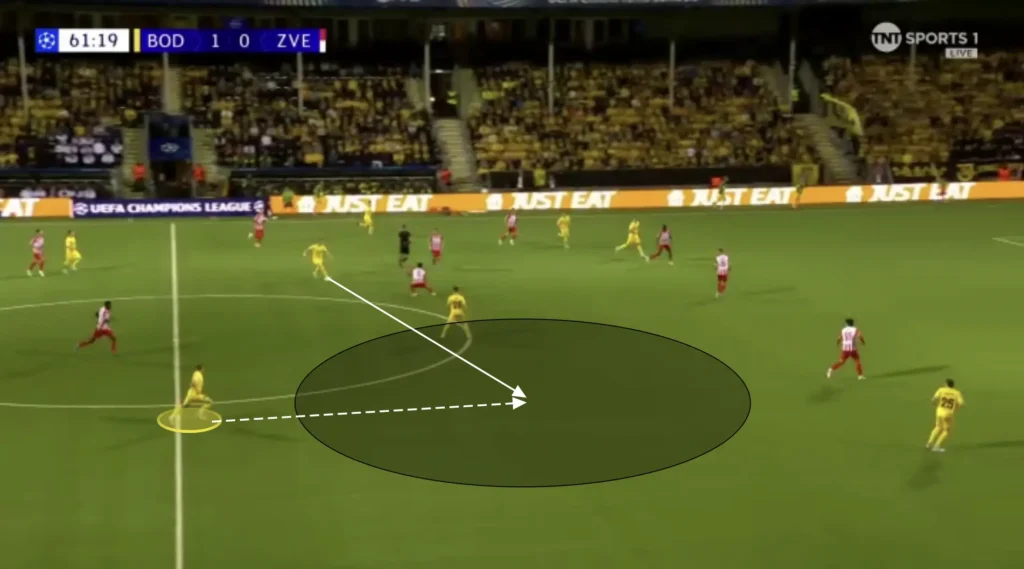
Finding the Pockets
Knutsen’s players always try to find the number-eights in the pockets. These “pockets” refer to the spaces between the opposition’s defensive and midfield lines, where the number-eights can receive the ball in more advanced positions.
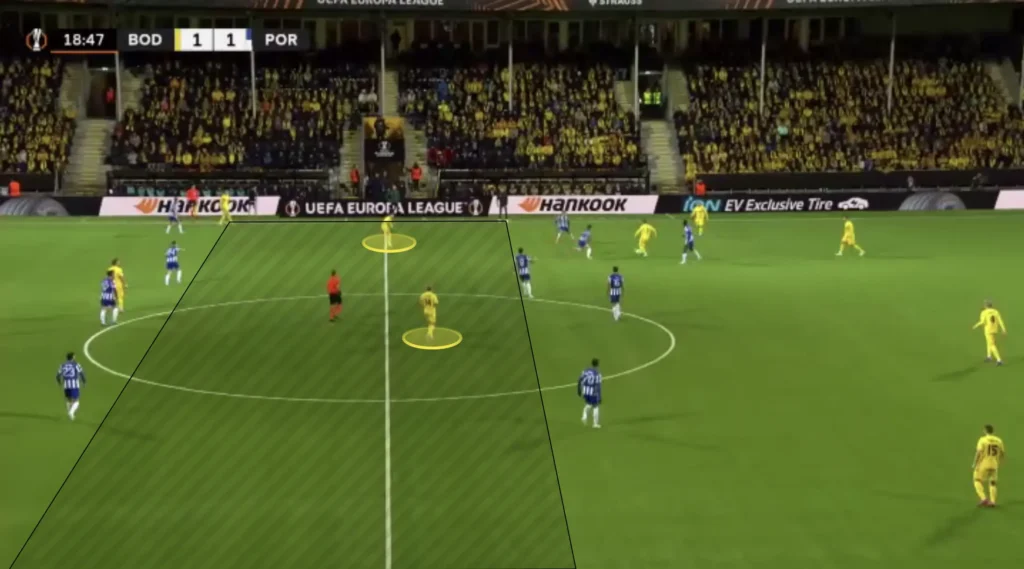
By positioning themselves intelligently in these pockets, the number-eights can turn quickly and face the opposition’s goal, creating opportunities for through balls, driving runs, or direct shots. This positioning forces the opposition to make difficult decisions. If an opposition defender steps up and closes down the Bodø/Glimt number-eight, he potentially leaves space behind. If he stays back, he allows the midfielder time on the ball. The Bodø/Glimt defenders and holding midfielders will look for straight passes, breaking the opposition lines and finding the number-eights who can turn and drive at the defense.
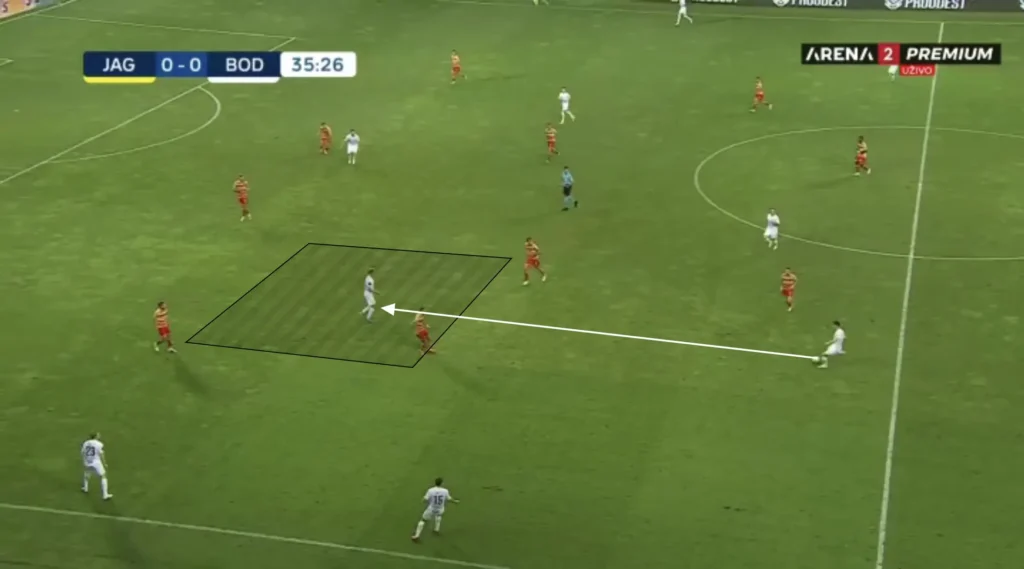
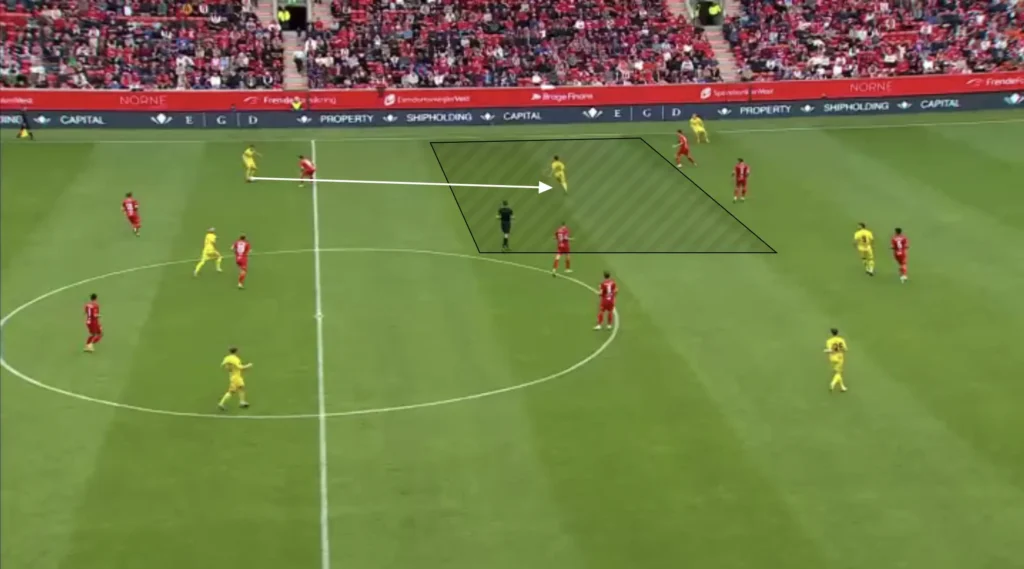
Bodø/Glimt will also use third-man combinations involving the striker to find players in these spaces. A defender or holding midfielder can play a straight pass to the striker, who can find a number-eight in the pocket with a simple one-touch pass.
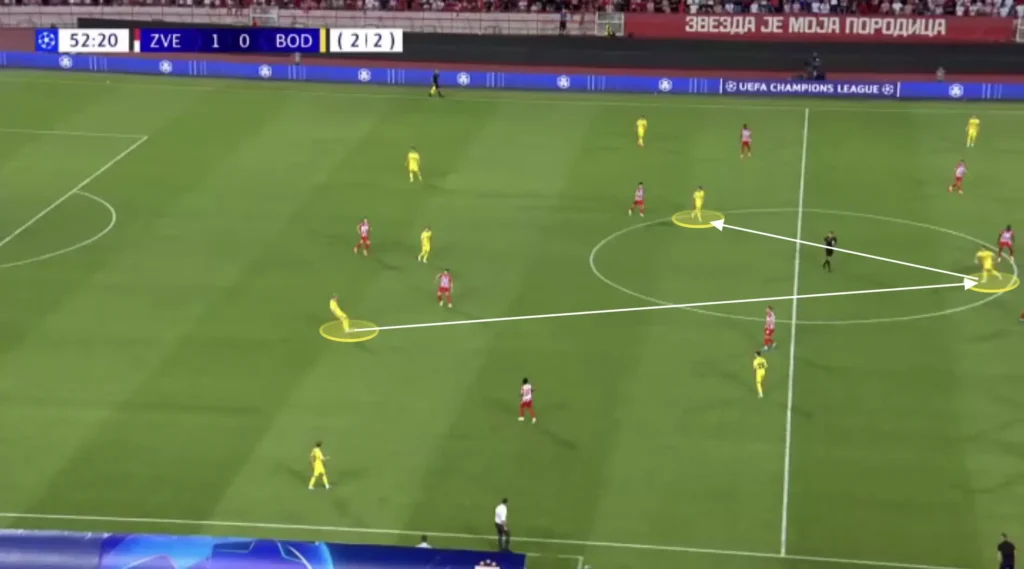
Finding these pockets is crucial for maintaining fluidity in attack and ensuring that the team can progress the ball effectively through the middle of the pitch.
Numerical Advantages Against the Opposition’s Defense
Another massive aspect of Bodø/Glimt’s high build-up is their ability to create numerical advantages against the opposition’s defensive line. The two number-eights will often move up into the forward line, creating a 1-4-1-5 formation. This gives Bodø/Glimt a front five. Playing with a front five means the forward line naturally becomes numerically superior against a back four, which Knutsen’s players are great at taking advantage of.
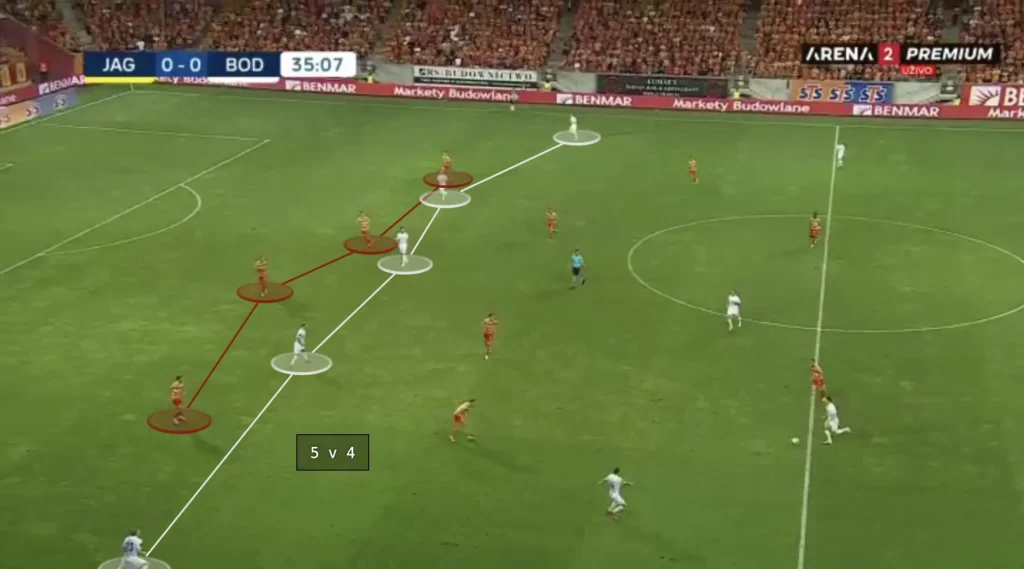
Bodø/Glimt will, for example, use counter-movements between the winger and number-eight to exploit this numerical advantage. When a Bodø/Glimt fullback has the ball, the number-eight can make a run in behind while the winger drops.
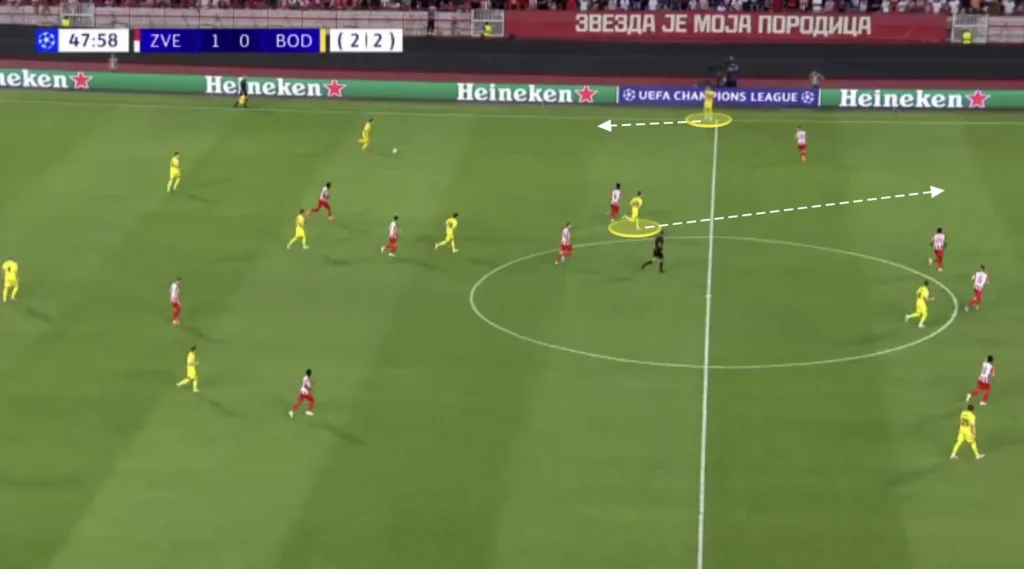
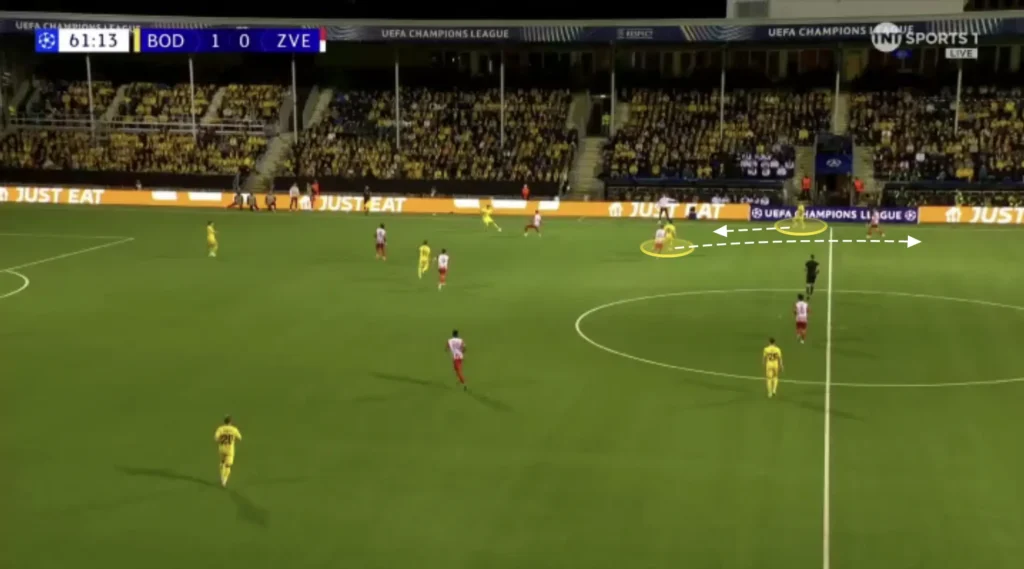
This creates a question for the opposition fullback. If he pushes up on the winger, the space behind him opens up, allowing the Bodø/Glimt fullback to play a through-ball to the running number-eight. However, if he stays inside to cover the run, the ball can be played to the winger, who can turn and attack the defense.
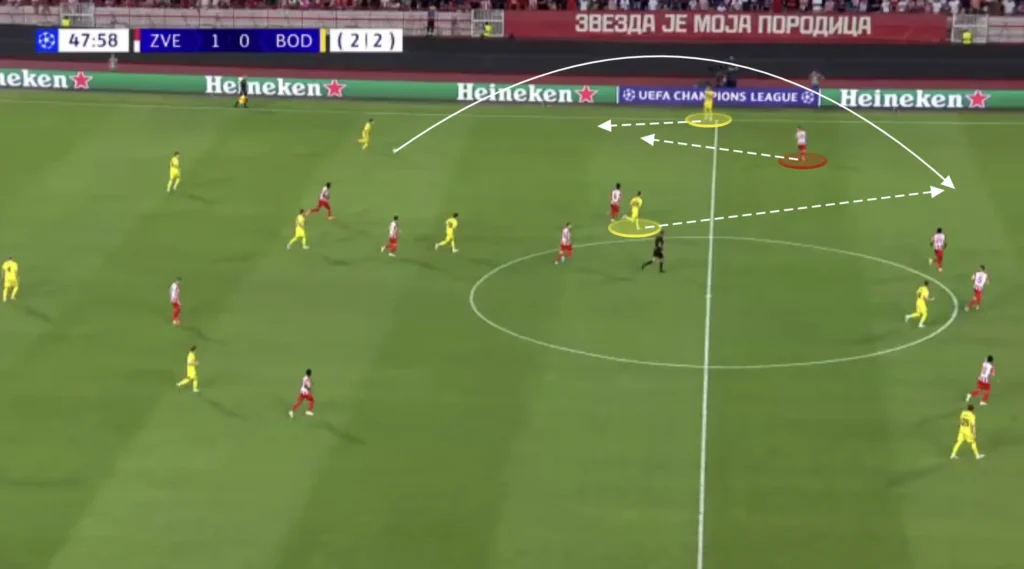
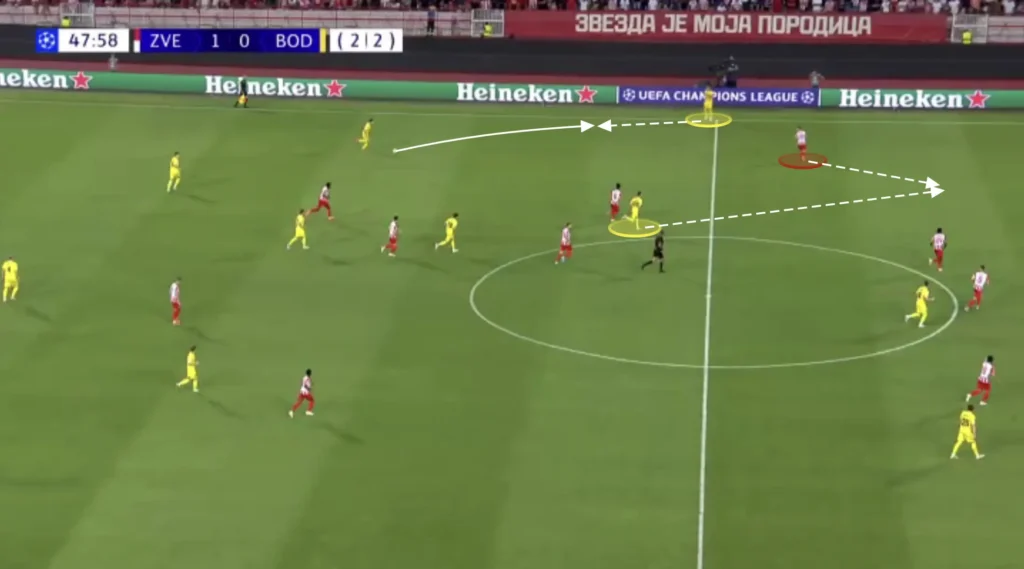
The Bodø/Glimt attackers will use counter-movements like these all the time. When one attacker drops, the other will go in behind, constantly creating questions for the opposition defenders.
Final Third
Wide Overloads
Bodø/Glimt excels at creating wide overloads to generate goalscoring opportunities. By pushing multiple players, including wingers, central midfielders, and overlapping fullbacks, into wide areas, they outnumber the opposition and create a numerical advantage on the flanks. This setup allows them to break down defenses by drawing opponents out of position and opening up space centrally. With quick, incisive passing and well-timed off-the-ball runs, Bodø/Glimt can exploit these wide overloads to deliver accurate crosses or cut-backs into the box. These crosses often find attackers arriving late or unmarked, resulting in high-quality chances and a significant threat in front of goal. This strategy not only stretches the opposition but also enables Bodø/Glimt to consistently generate dangerous scoring opportunities from the wings.
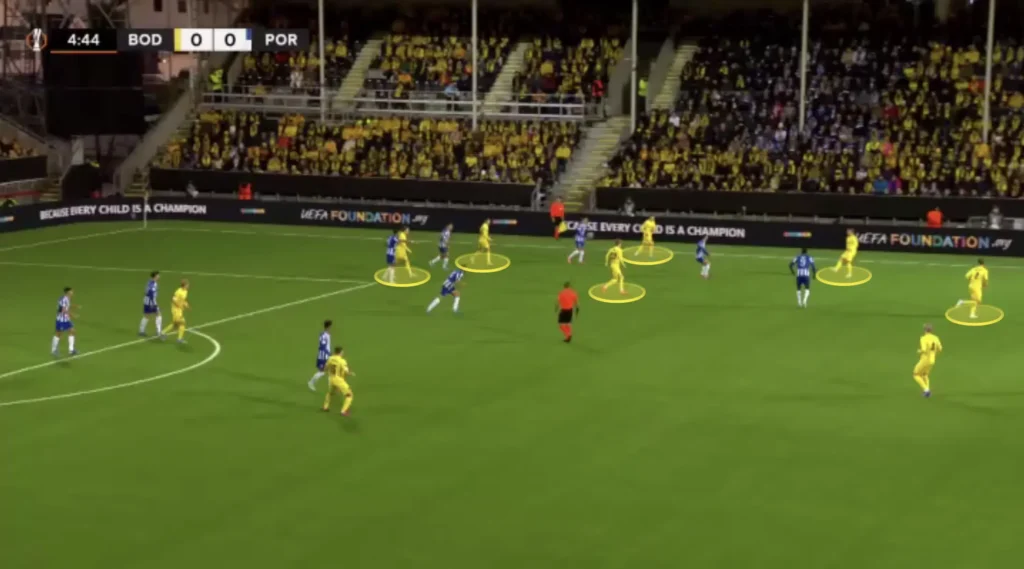
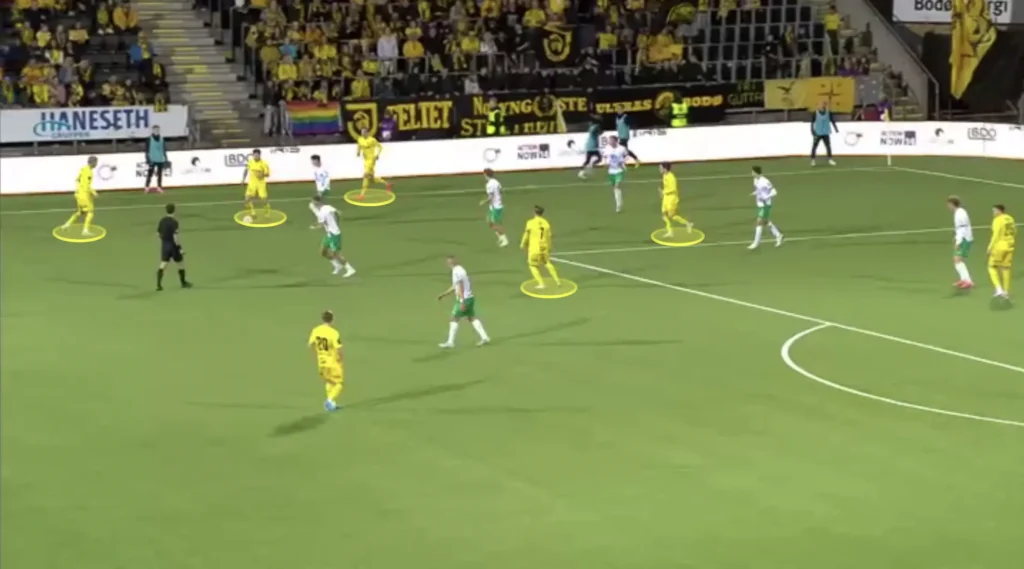
Overlaps
Bodø/Glimt have effectively used overlaps as a key tactic to create goal-scoring opportunities under Kjetil Knudsen. This involves wide players, usually fullbacks, making forward runs to get around their winger, providing an extra attacking option on the flanks. By doing so, they create a 2v1 situation with the winger against the opposition fullback, which could be used to beat the fullback and create crossing opportunities.
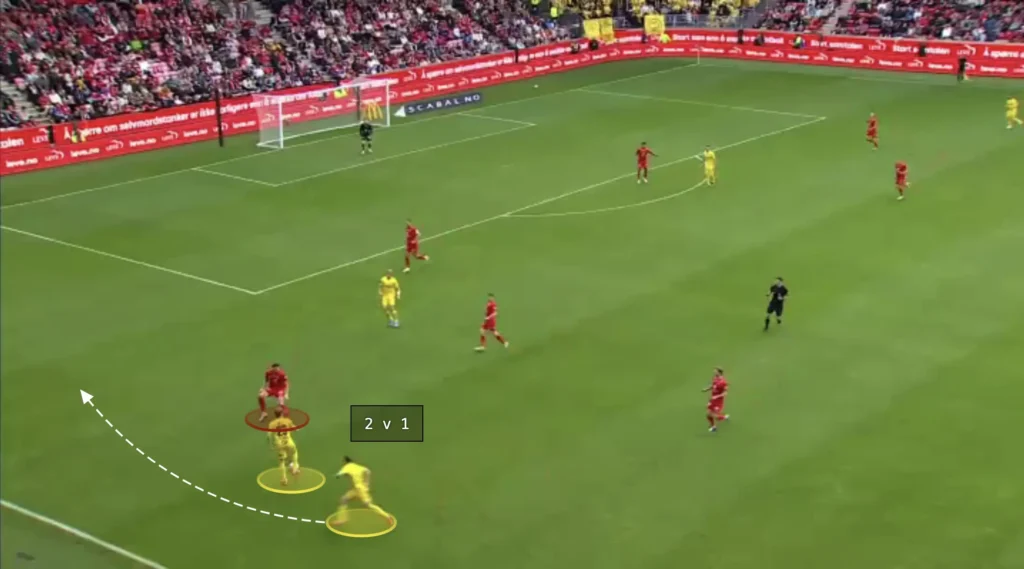
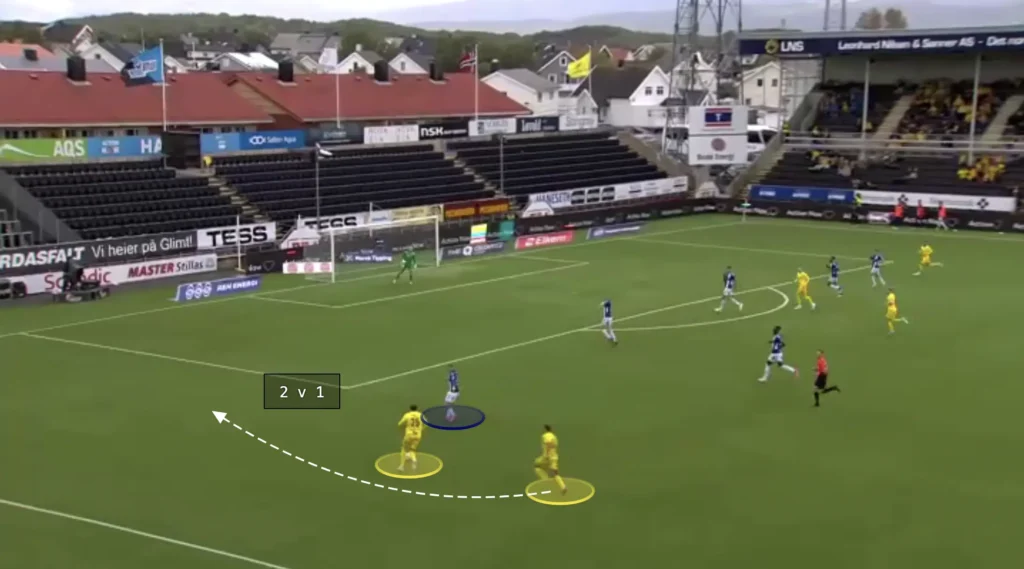
Bodø/Glimt’s wingers often initiate the play by attracting the opposition fullback, leaving space for an overlapping fullback to exploit. The overlap forces the defending fullback to make difficult decisions—either stick with the winger or follow the overlapping fullback. If the opposition fullback drops to cover the overlapping run, the winger could cut inside, taking a shot or combining with a midfielder. If the fullback covers the center, the ball can easily be played to the overlapping player, creating a crossing opportunity.
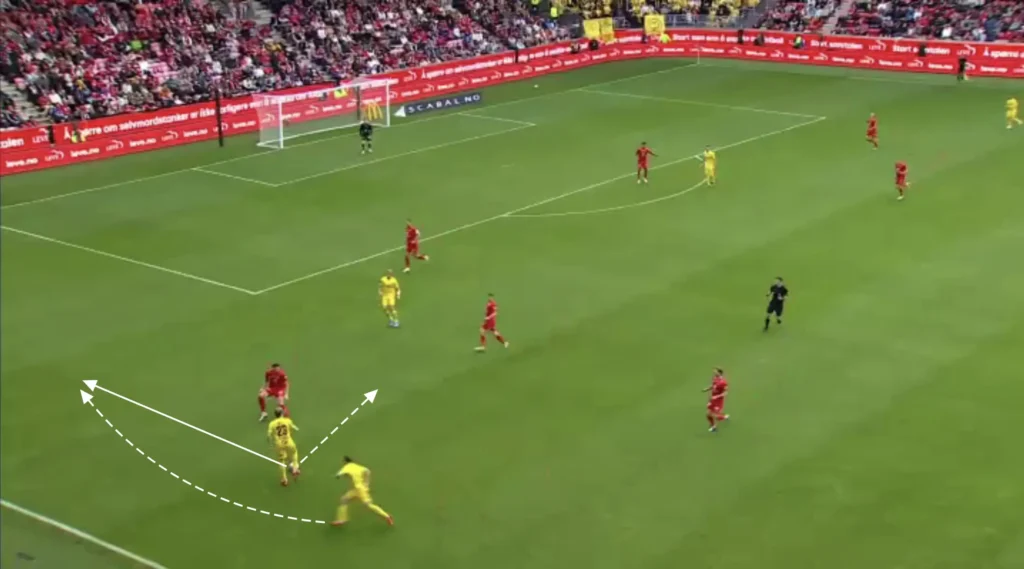
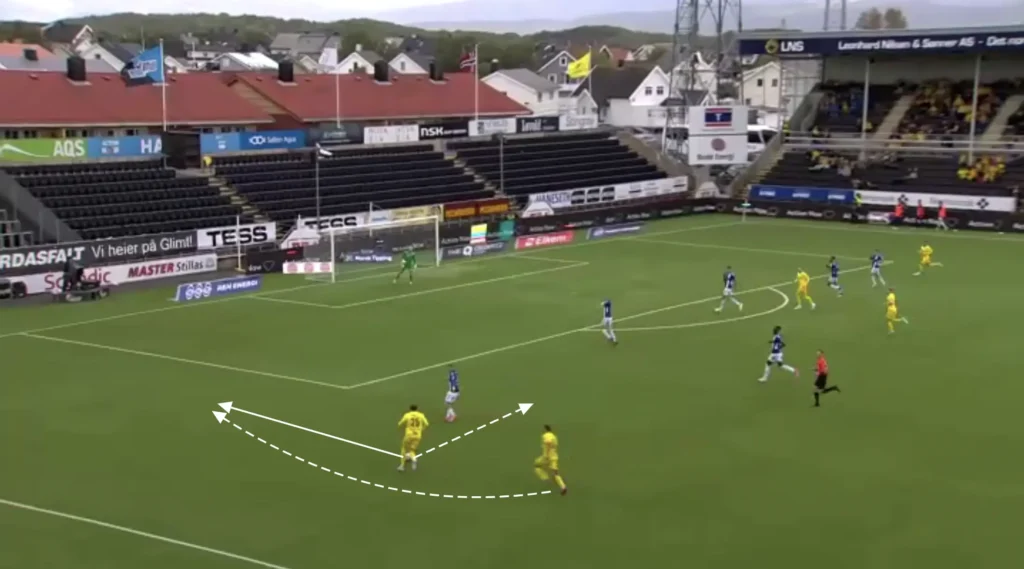
This use of overlaps has been a crucial element of Knudsen’s attacking strategy, adding variety to Bodø/Glimt’s offensive play and increasing their threat in the final third.
Underlaps
Bodø/Glimt will also use underlaps to produce opportunities in the final third. They primarily do this from the wide areas with runs from the number-eights or fullbacks into the space between the opposition fullback and center-back.
When the winger receives the ball out wide he will attract the opposition fullback. This opens the space between the fullback and the center-back, which allows Bodø/Glimt’s number-eight or fullback to make the underlapping run into this space. The ball can be played to the underlapping player, who can cross the ball into the box or attack his defender in a 1v1 situation.
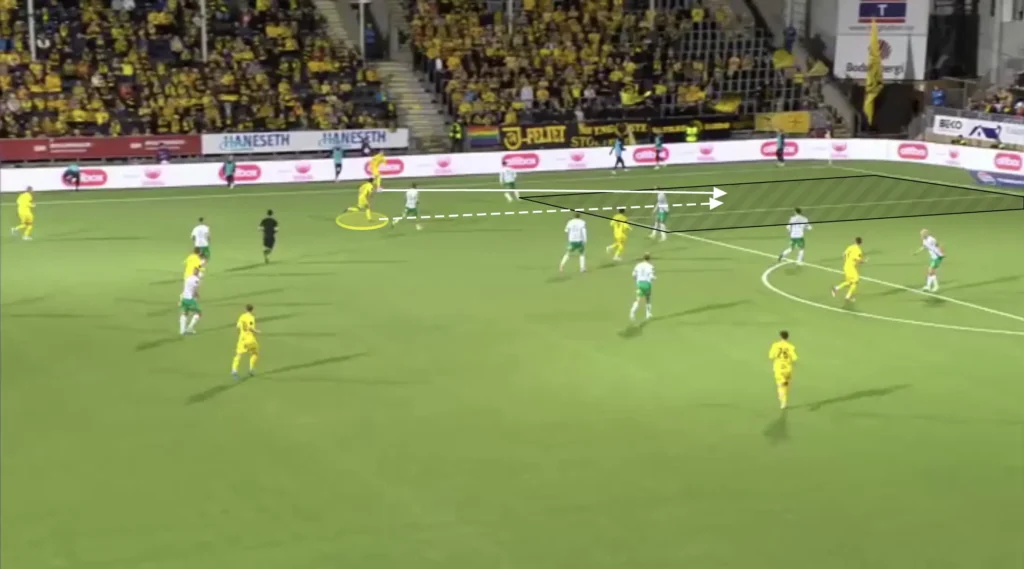
The winger does not have to play the ball to the underlapping player. The run from the number-eight or fullback will often drag away an opposition defensive midfielder, which opens the space inside. The winger can take the ball inside and shoot or find a pass to a free player in front of the backline.
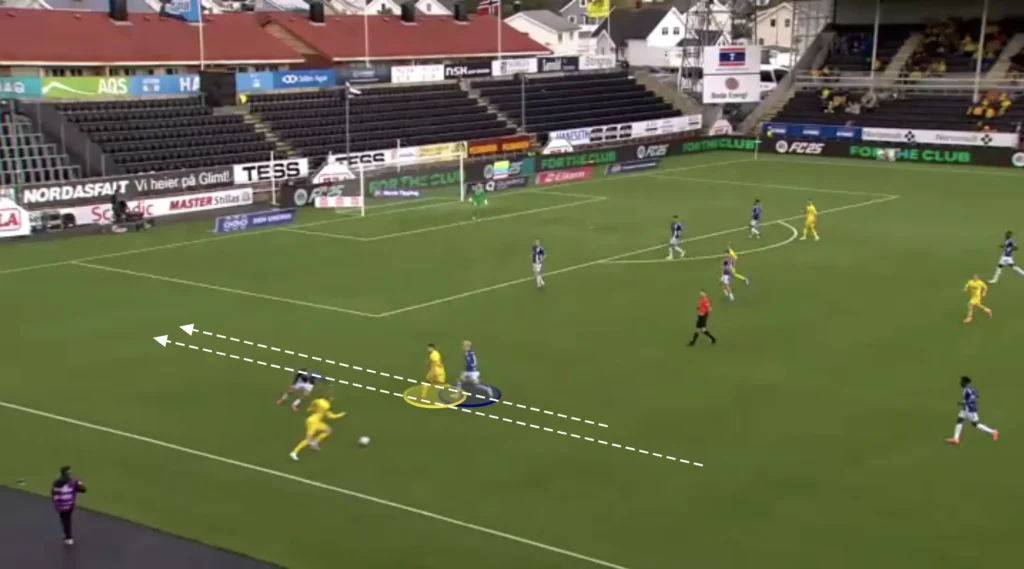
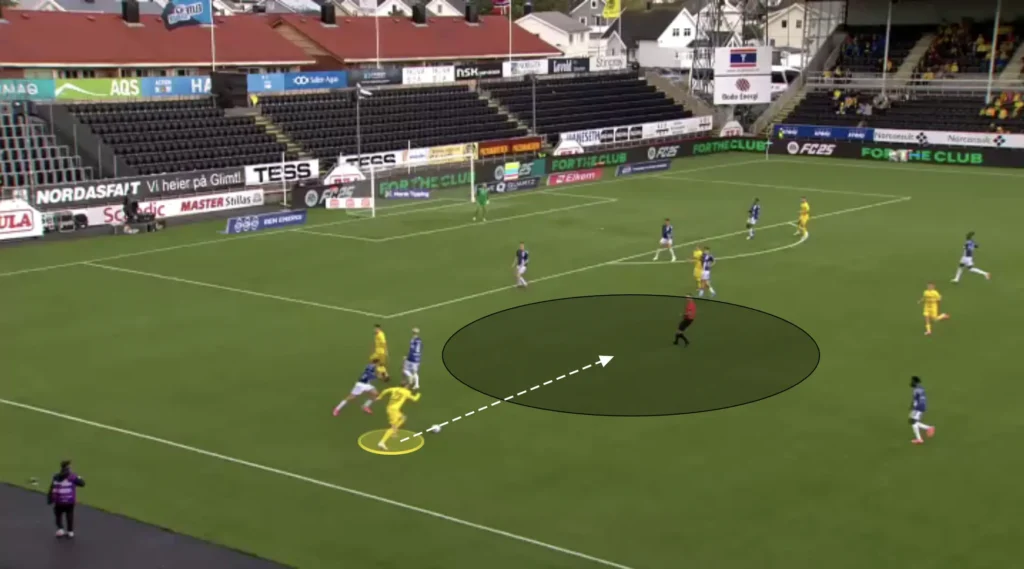
Many Players in the Box
The midfielders and wingers always look to make runs into the box when the ball is in the final third, often getting four or five players into these areas to create overloads. The numerical advantages in the box increase the chances of connecting with the cross, as more players present multiple targets for the crosser, making it harder for defenders to mark everyone effectively. Additionally, having multiple players in the box provides options for different types of finishes, whether it’s a header, volley, or a quick tap-in. It also allows for better positioning to react to second balls or rebounds, increasing the likelihood of capitalizing on any defensive errors.
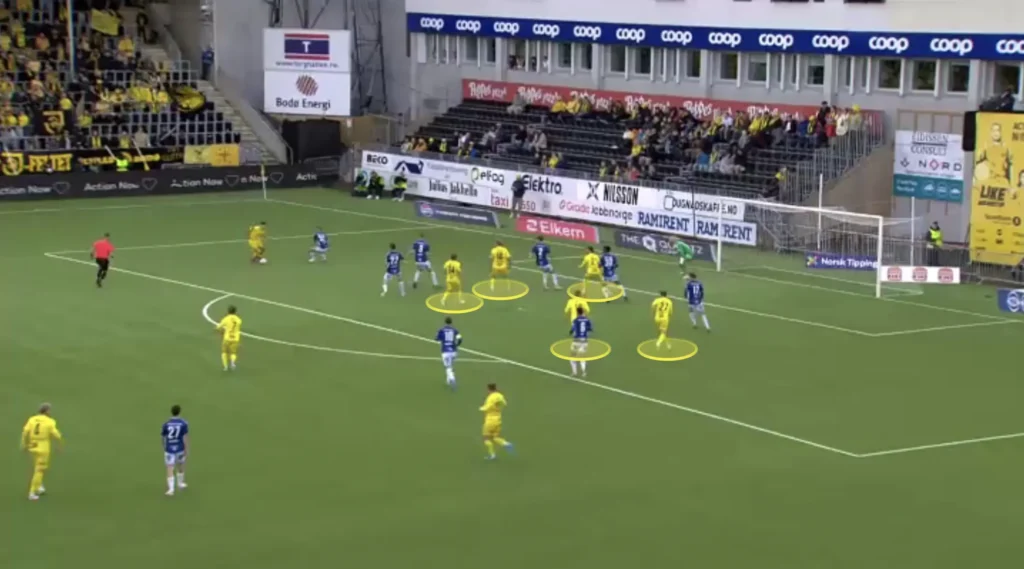
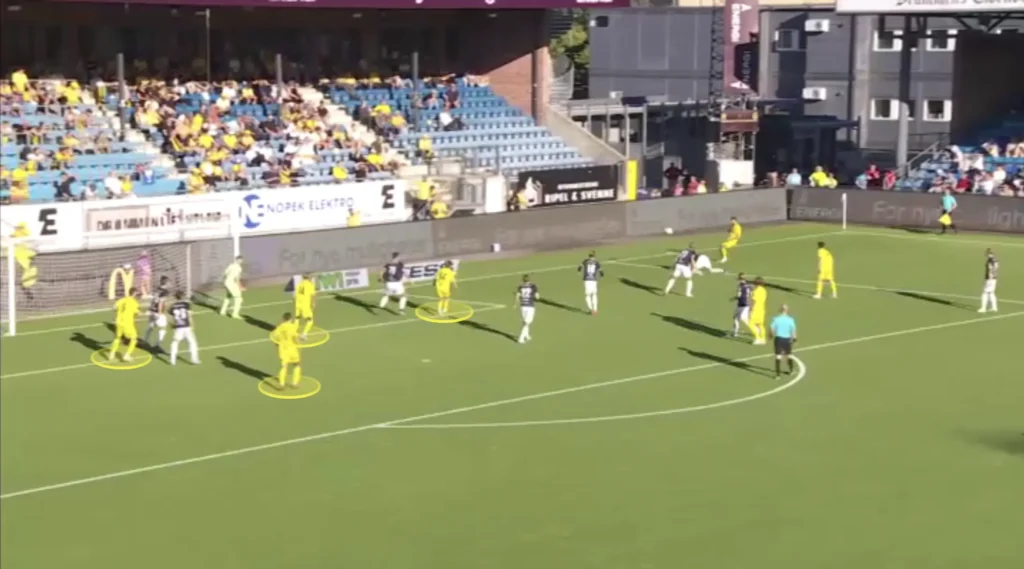
Knutsen also positions many players outside the box, ready for the second balls and cut-backs. Bodø/Glimt will often create crossing opportunities through their wide attacking play, which pushes down the opposition’s defense and opens the space in front of the opposition’s backline. The central midfielders and sometimes fullbacks can collect any loose balls or be found directly in these spaces with cut-backs, and from there, they can shoot or combine with an attacker to create goalscoring opportunities.
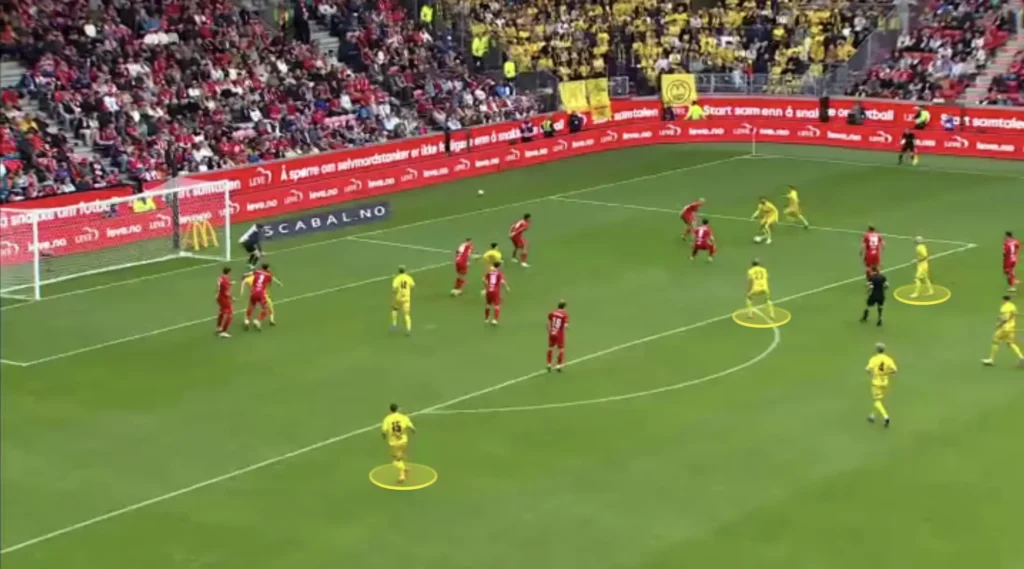
Defending
High Press
Bodø/Glimt usually look to press the opposition high up the pitch. Their pressing structure will depend on the opposition, but they primarily press in a 1-4-1-3-2 formation.
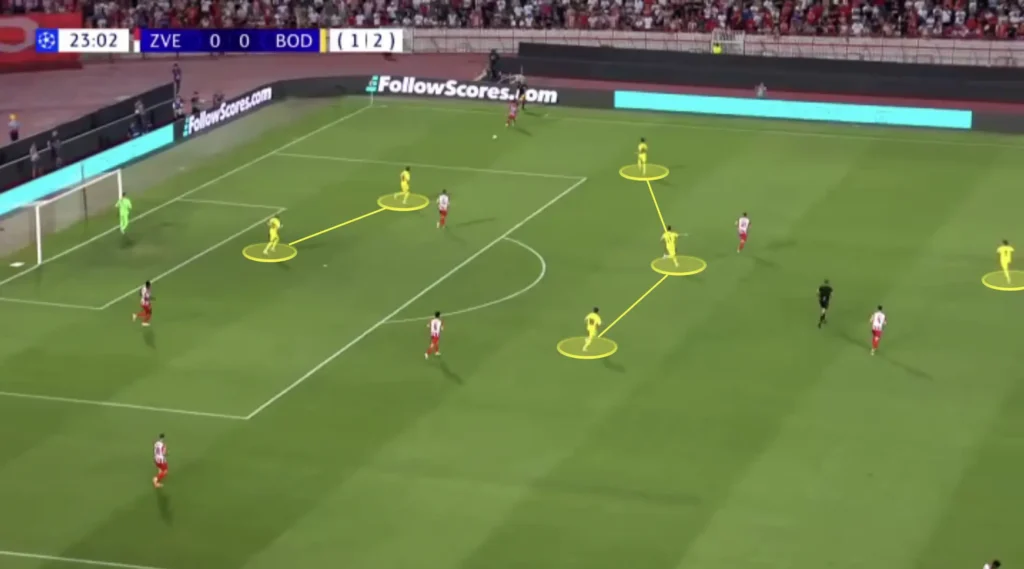
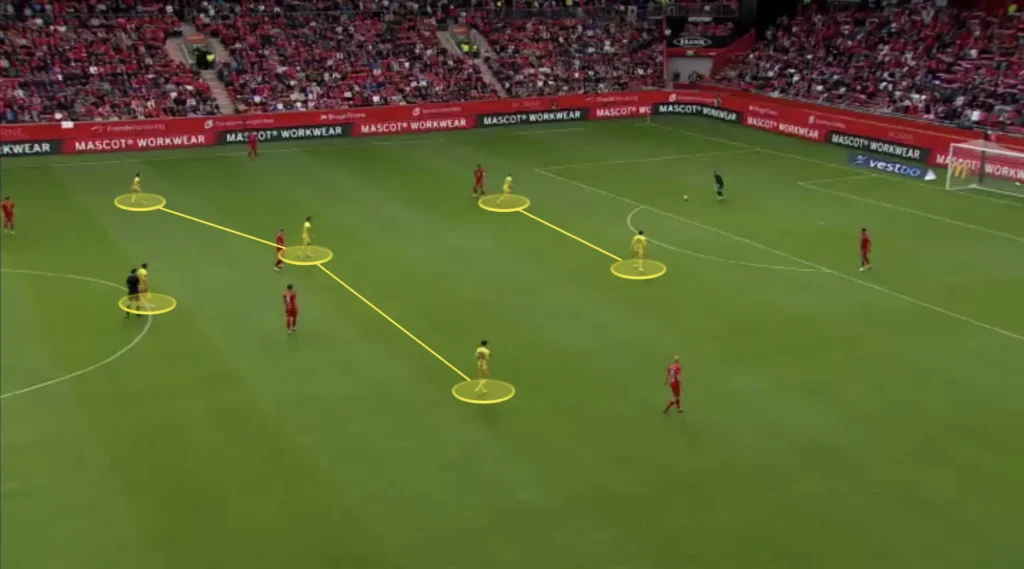
When the play starts, the strikers will try to close off one opposition center-back by making angled pressing runs, forcing the opposition to one side. Bodø/Glimt will be extremely aggressive and intensely press to win the ball when it gets played out to one of the opposition fullbacks. The ball-side wide midfielder will push up on the ball-side fullback, with the rest of the midfield shifting across to close down any passing options. The wide midfielder will press from the inside, closing any passes into the middle. The ball-side striker will try to stop the opposition from switching sides by closing the pass to the ball-side center-back, while the far-side striker comes across to be ready to press the goalkeeper. This gives the opposition fullback very few passing options and often triggers a rushed long ball.
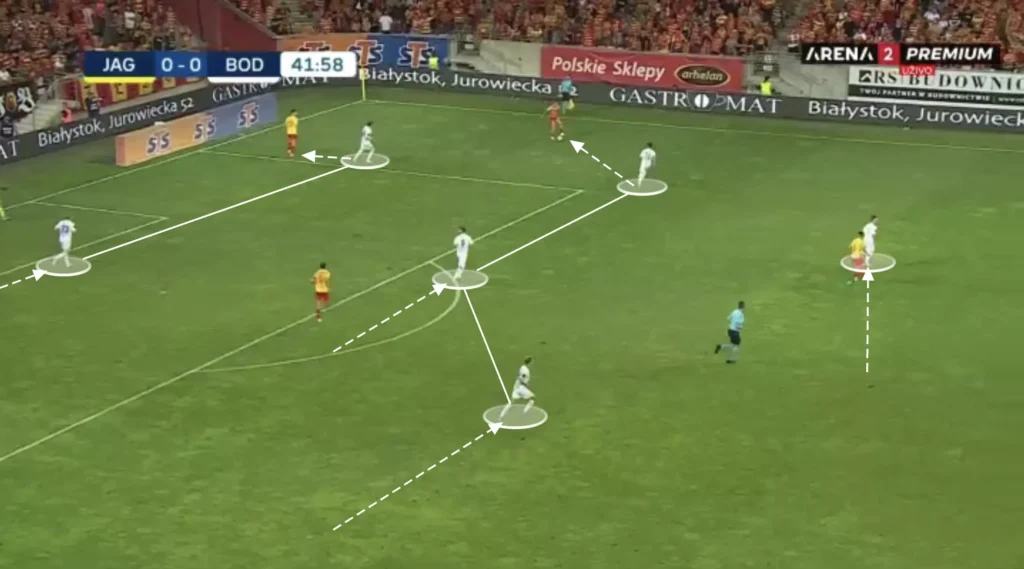
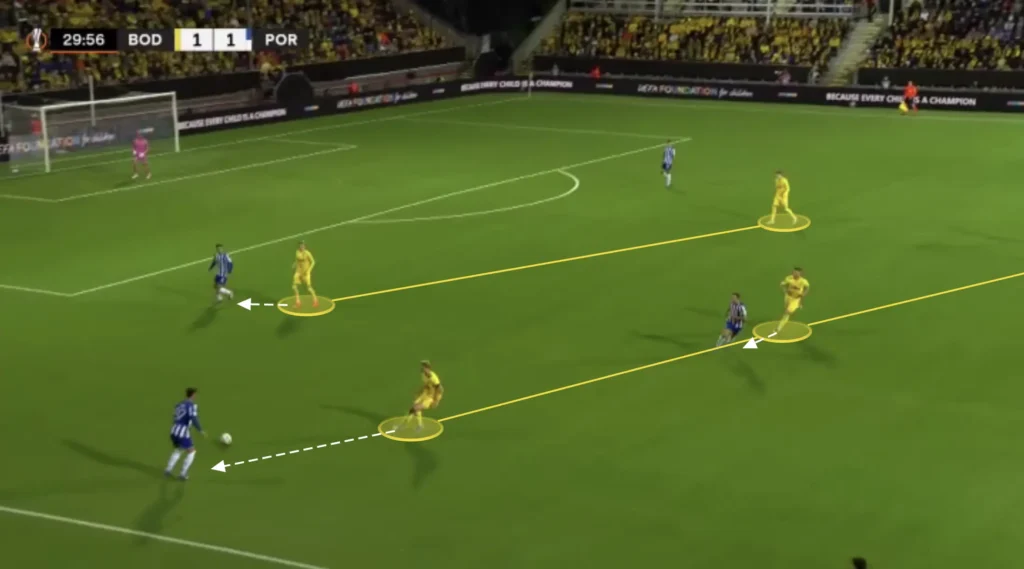
Additionally, this system gives the Bodø/Glimt backline a numerical advantage against the opposition attackers, which means they usually win the long balls.
Low Press
Bodø/Glimt’s base formation when defending is the 1-4-3-3 formation. They look to set up in a mid-block, always trying to close the center and force the opposition out wide.
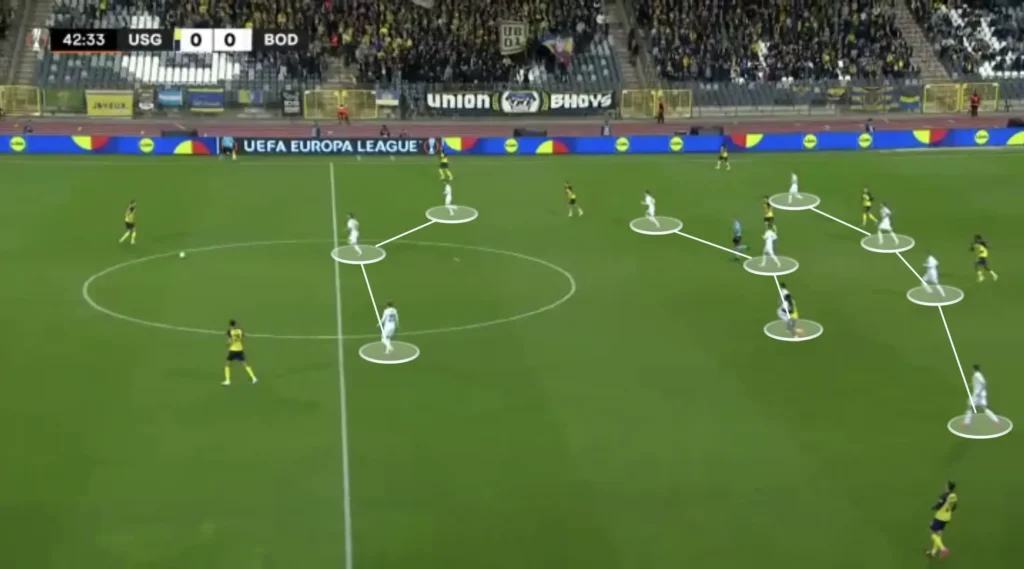
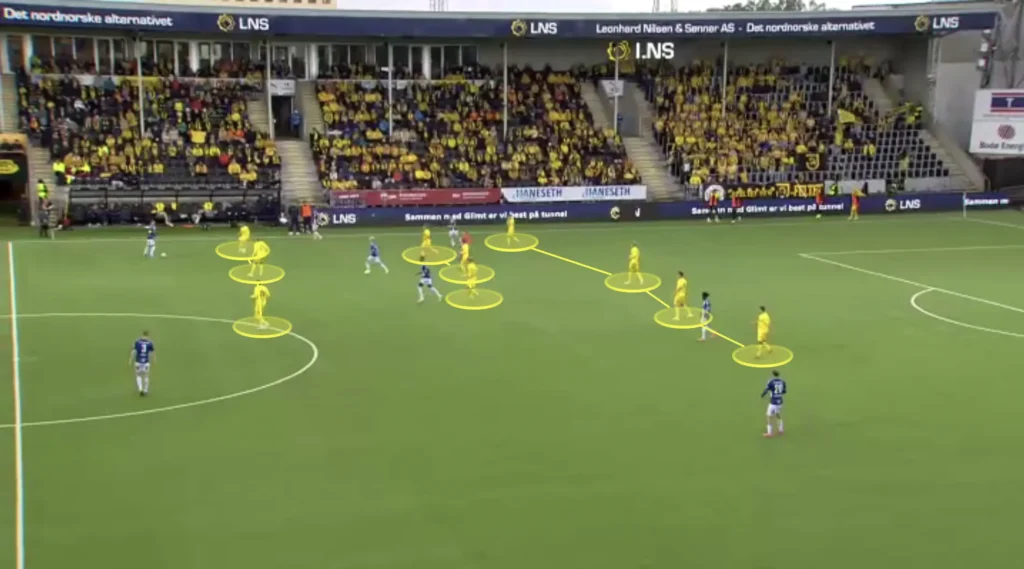
Defending in a 1-4-3-3 formation, with the wingers higher up, is centered around maintaining a compact forward line that forces the opposition to progress the ball on the flanks. The team should be a cohesive unit where the three midfielders play a crucial role in shielding the back four while also supporting the high press. The 1-4-3-3 is effective in closing down the center of the field, making it difficult for opponents to penetrate through the middle, and pushing them into less dangerous wide areas.
In Bodø/Glimt’s defensive system, the wingers will usually press the opposition center-backs while the striker covers the opposition’s holding midfielders. When the wingers press the center-backs, they close the passing lanes to the opposition fullbacks/wingbacks. This forces the opposition center-backs into the middle, where Knutsen wants to win the ball with the striker and central midfielders, who block off all passes into the opposition’s midfielders.
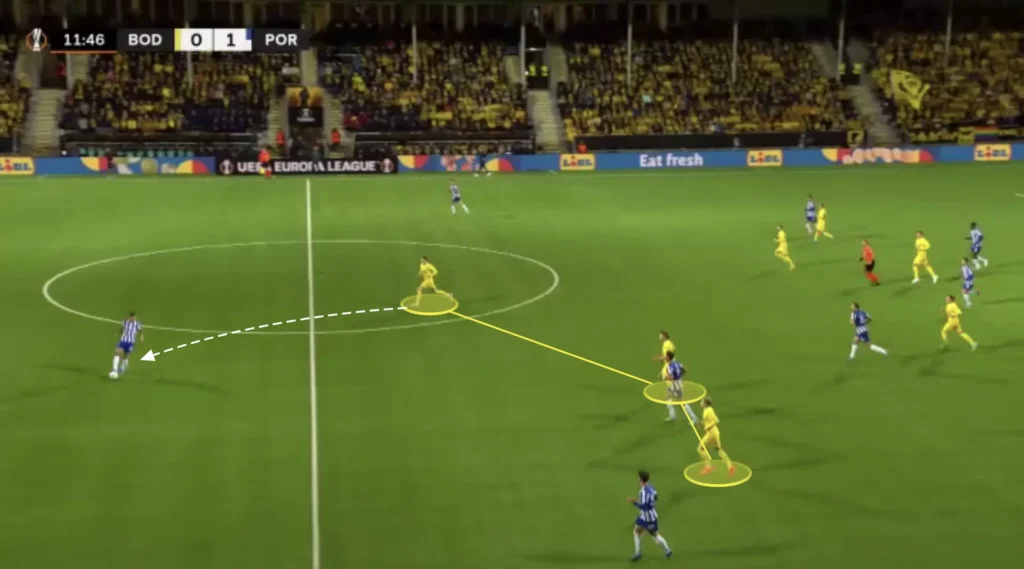
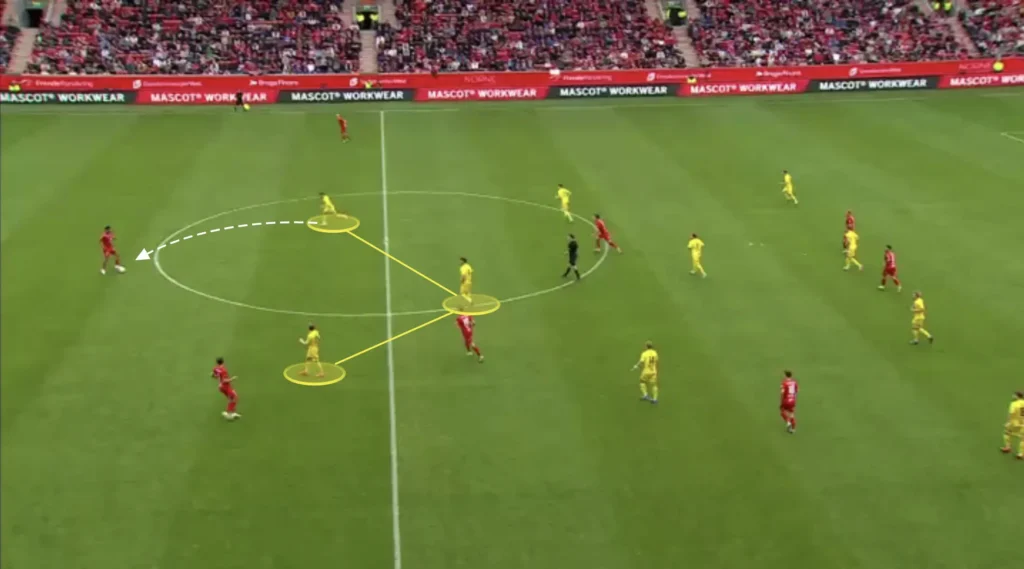
If the opposition center-back manages to find the fullback with a pass, beating the forward line, a central midfielder has to break out to stop the fullback from advancing. If a central midfielder breaks out, the two remaining midfielders must shift across to close the space in the midfield.
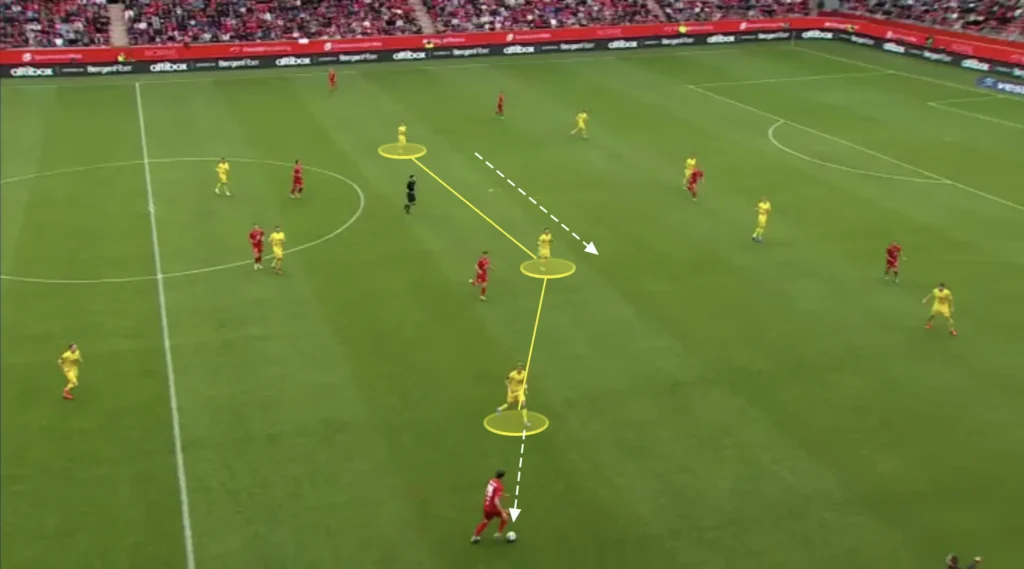
Additionally, the Bodø/Glimt striker will drop back when the opposition fullback gets the ball to close off the pass inside to the holding midfielder.
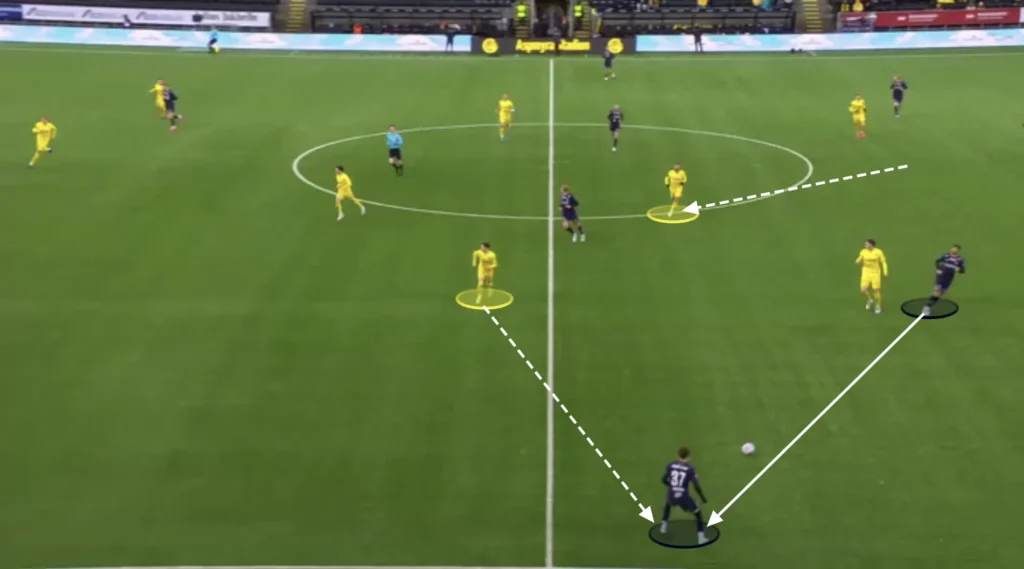
Bodø/Glimt have also used a 1-4-3-1-2 formation when defending, where the striker permanently moves down as a number-ten.
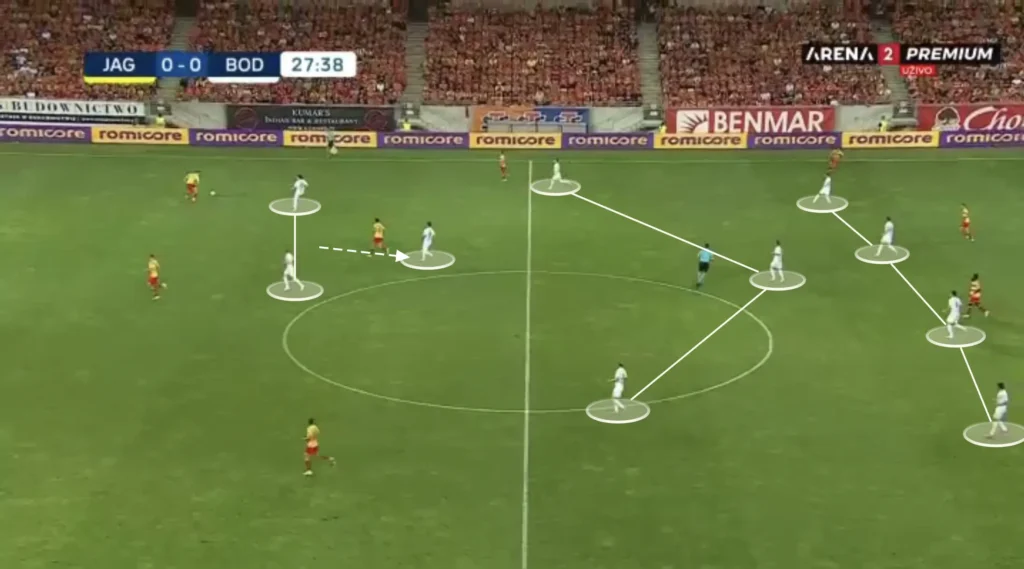
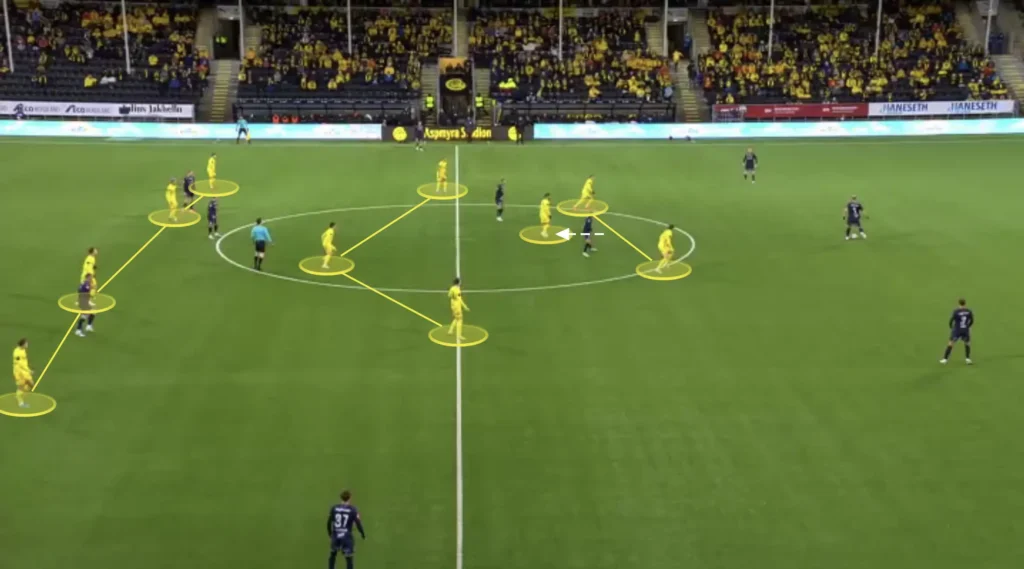
This setup is better suited to crowding the midfield and disrupting the opponent’s build-up through the center, but it can leave the flanks more exposed.
Squeezing the Pitch
Kjetil Knutsen always wants his team to squeeze the pitch when defending. This means constantly pushing the team up as much as possible. Every time the opponent plays a slow, sideways pass or a back pass, Bodø/Glimt’s first line of pressure pushes up, with the rest of the team following to stay compact. When the next pass comes, they push up even more, forcing the opponent back even more. They do this because it pushes the opponent further away from the Bodø/Glimt goal, making it harder to create chances.
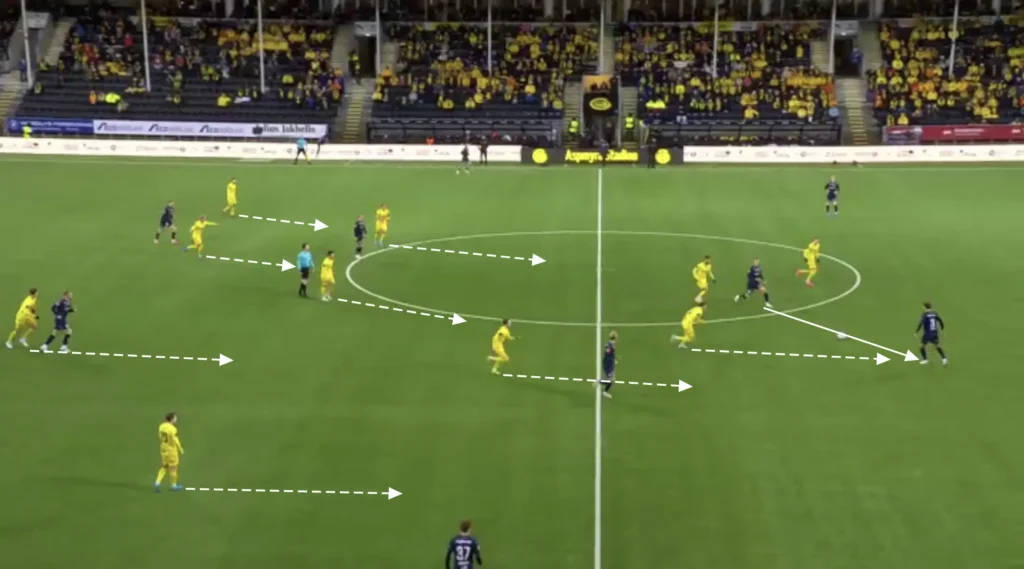
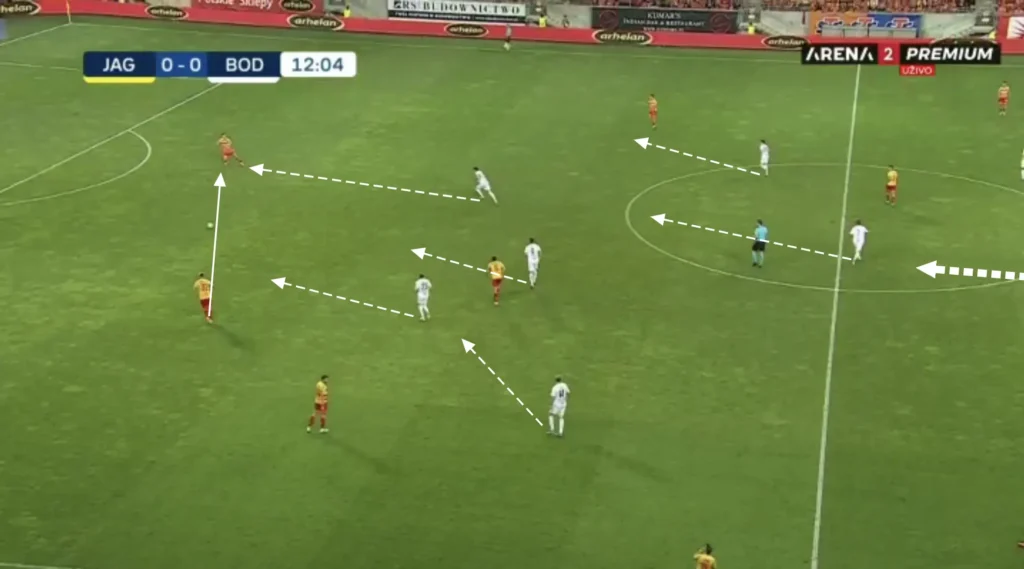
Transitions
Defensive Transitions
Bodø/Glimt are great in defensive transitions. They usually have many players high up and close to the ball, which creates good conditions for counterpressing. Many players close to the ball after losing possession means that many players can work towards regaining possession. Knutsen’s players are also very aggressive in the first seconds after losing the ball. The four or five players closest will immediately jump on the opposition player with the ball and close the distance to cut off any passing lanes. This approach disrupts the opponent’s transition from defense to attack, forcing errors and creating opportunities to regain control in dangerous areas.

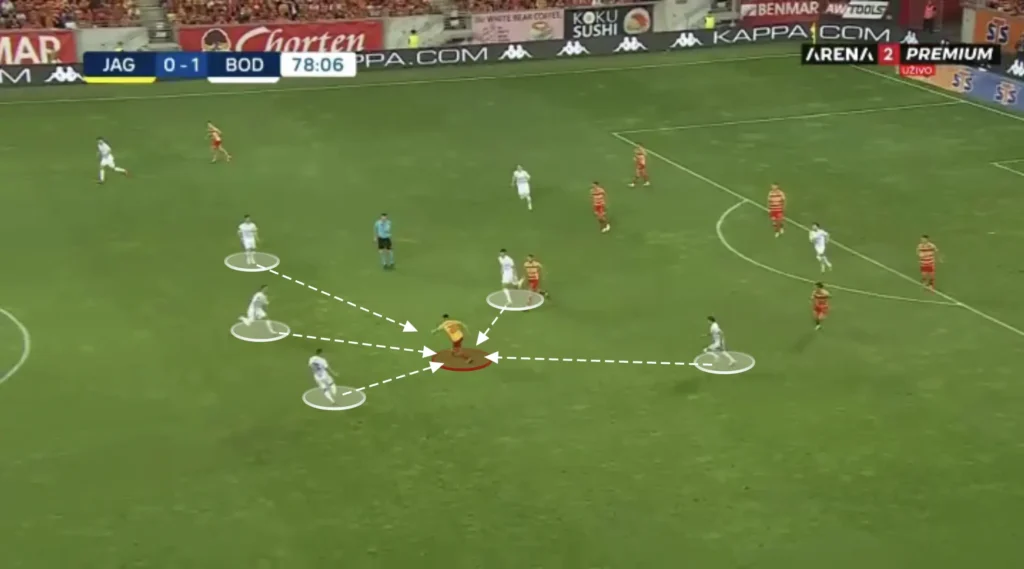
Counterpressing like this keeps Bodø/Glimt on the front foot, allowing them to dominate possession and create more scoring opportunities. However, it requires exceptional fitness, tactical discipline, and teamwork.
Offensive Transitions
Kjetil Knutsen also wants his team to counterattack in their offensive transitions. When winning the ball back, the team transitions quickly from defense to attack, utilizing the speed and movement of their forward players. Knutsen emphasizes vertical passes to exploit spaces left by the opposition, often targeting wide areas or gaps between defenders. Bodø/Glimt’s counterattacks are well-organized, with players making intelligent off-the-ball runs to create overloads and support the ball carrier. This quick, direct style catches opponents off guard, making Bodø/Glimt a dangerous team on the break.
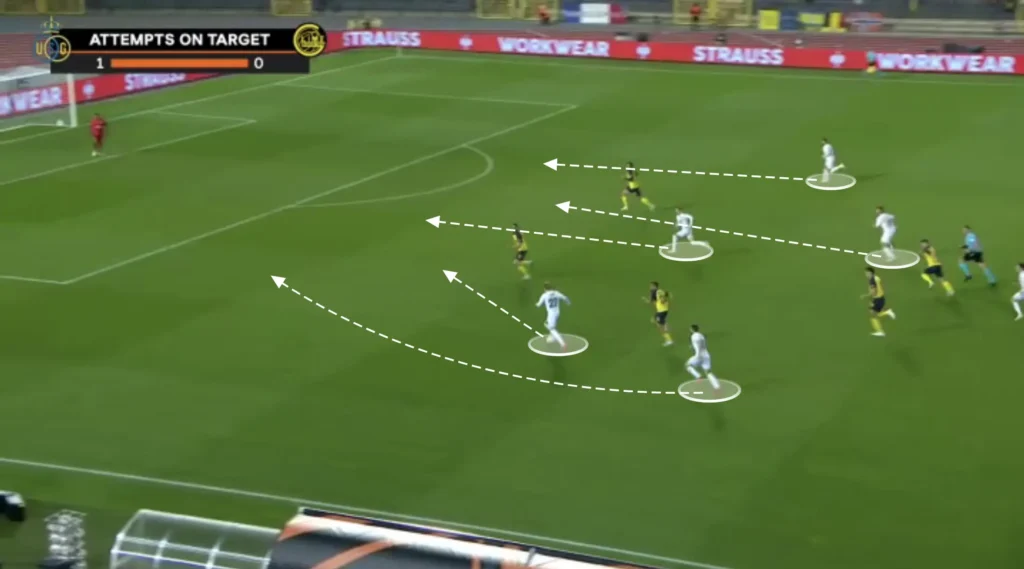
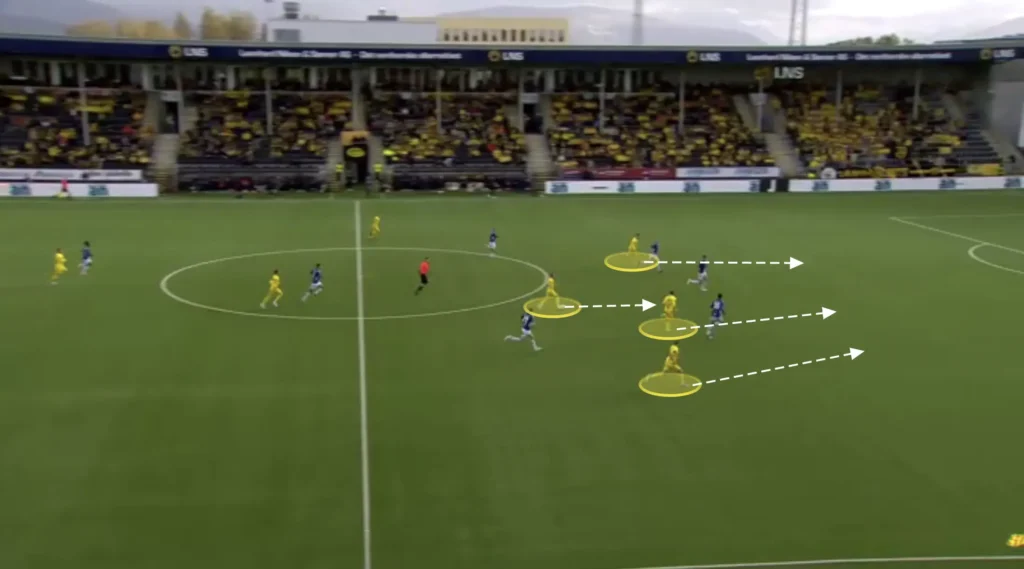
Additionally, the Bodø/Glimt players are great at finding the open spaces in the counterattacks. When they win the ball, instead of playing the ball straight forward where opposition defenders may still be positioned, they play a diagonal pass, allowing the team to bypass pressure and shift the play into open areas. From these areas, the Bodø/Glimt attackers can take the ball forward and combine with each other to quickly get past the opposition and create a goalscoring opportunity.
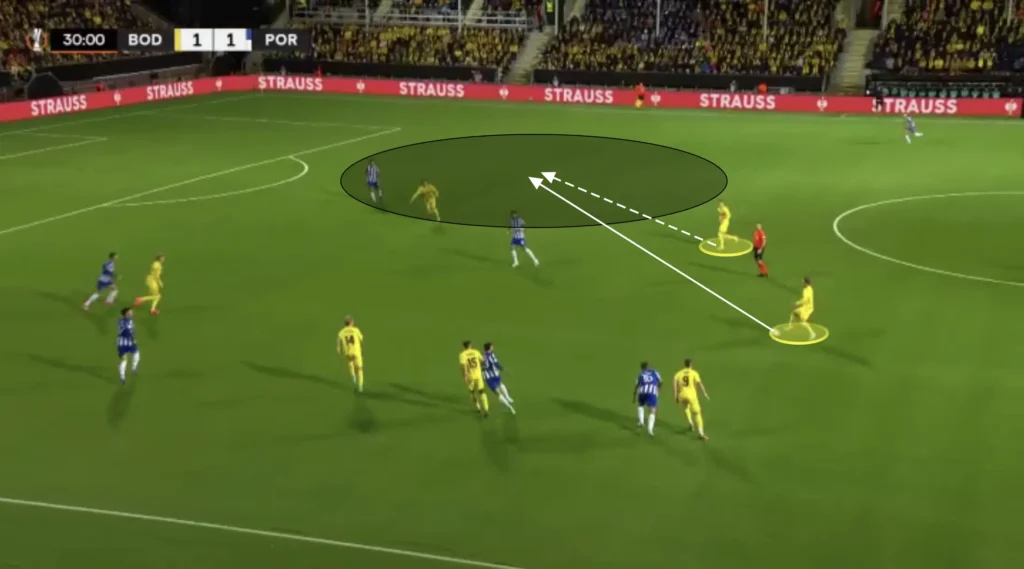
Bodø/Glimt’s aggressiveness also means they have many players high up when defending, which enables them to incorporate more players into the counterattacks.
Final Thoughts
In conclusion, Kjetil Knutsen’s tactical approach at Bodø/Glimt has transformed the team into a formidable force, known for its high-energy, attacking style and disciplined organization. His emphasis on fluid attacking movements, effective pressing, and versatile formations has allowed Bodø/Glimt to punch well above their weight, competing fiercely both domestically and in European competitions.
Knutsen’s ability to maximize player potential and foster a cohesive team spirit has been integral to Bodø/Glimt’s success. The tactical structure and the adaptability demonstrated by the team highlight the strategic depth and vision Knutsen brings to the game. As Bodø/Glimt continues to develop under his leadership, the team’s tactical journey remains a compelling story, showcasing the impact of innovative coaching and strategic discipline in modern football.
